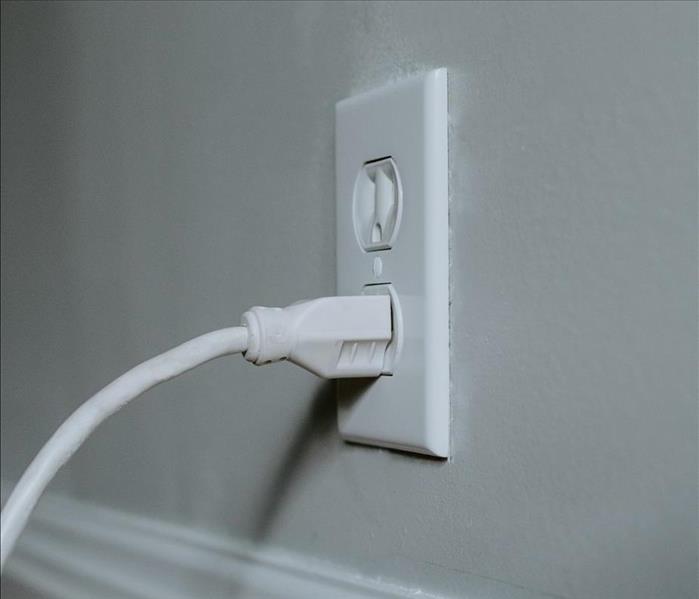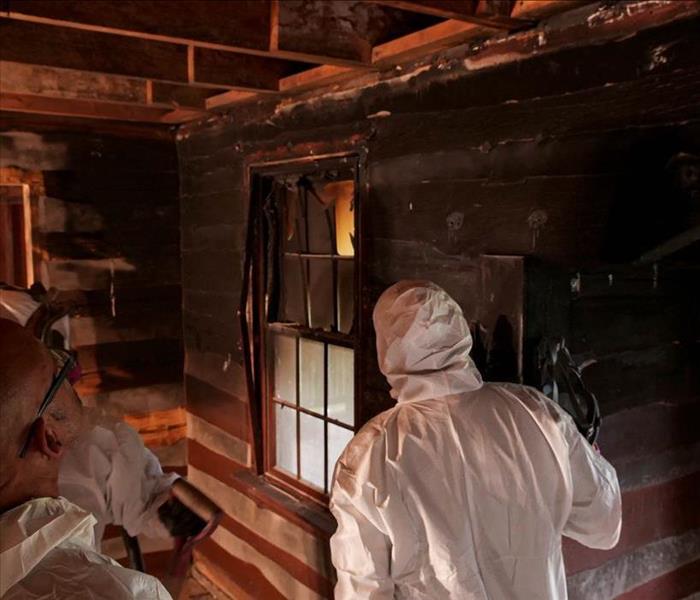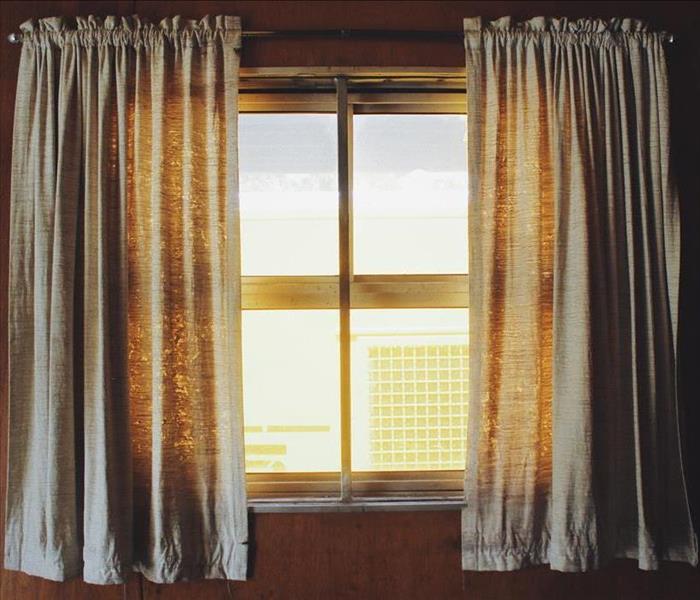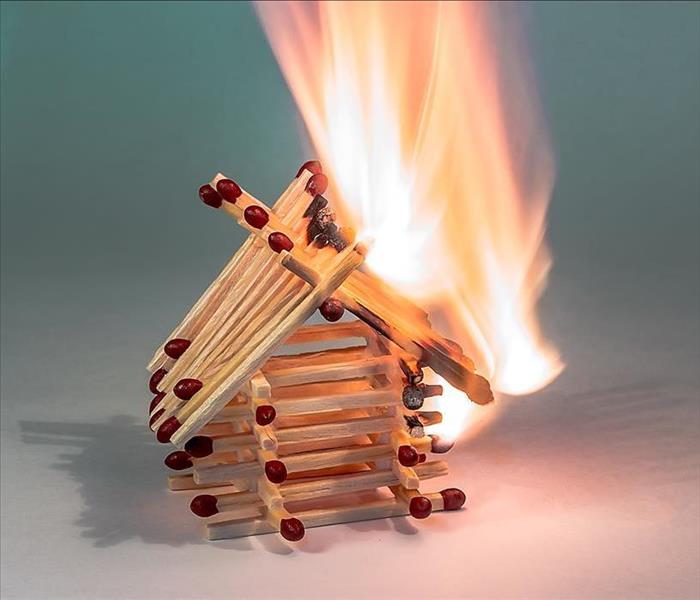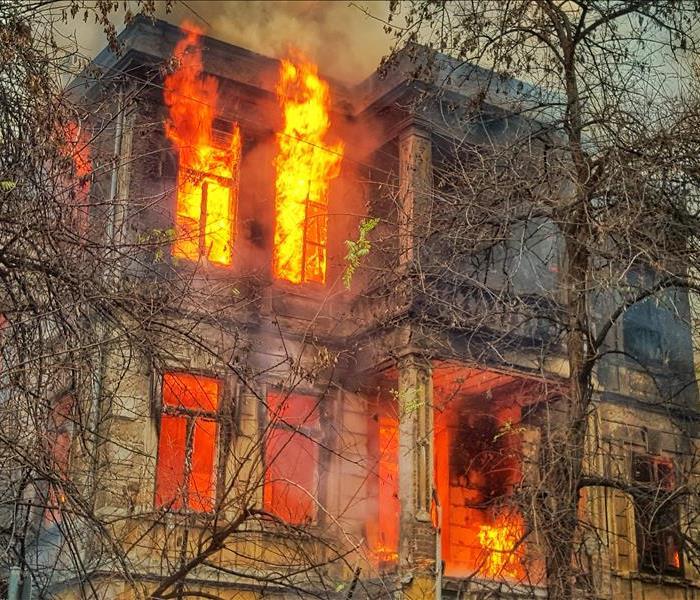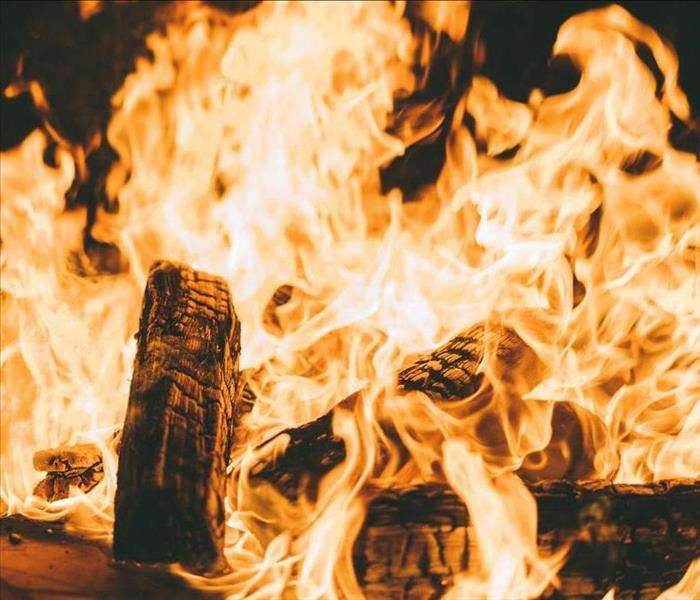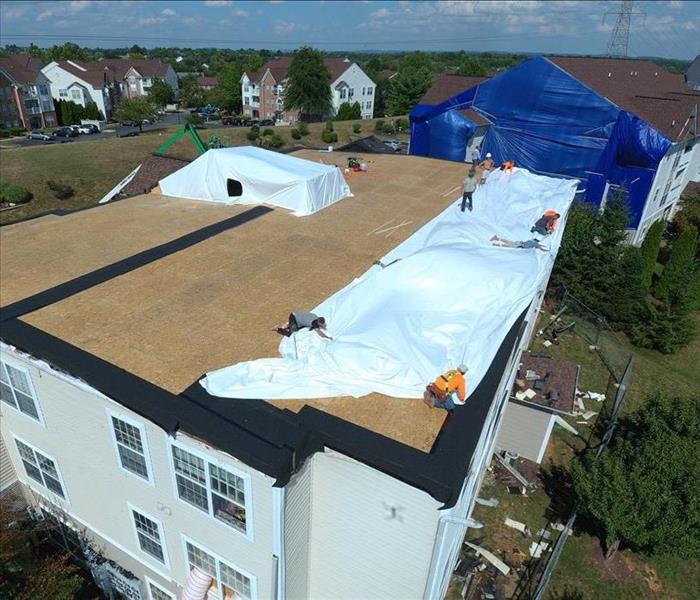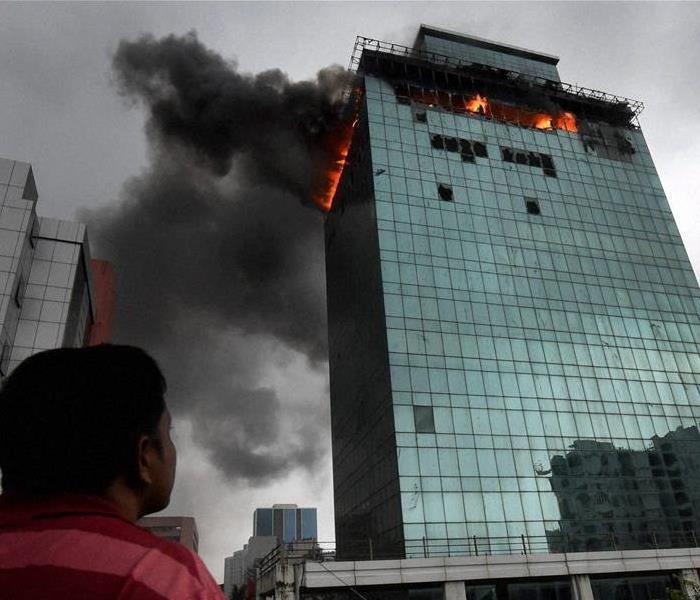Archived Fire Damage Blog Posts
Kitchen Fires: How to Be Prepared
12/26/2022 (Permalink)
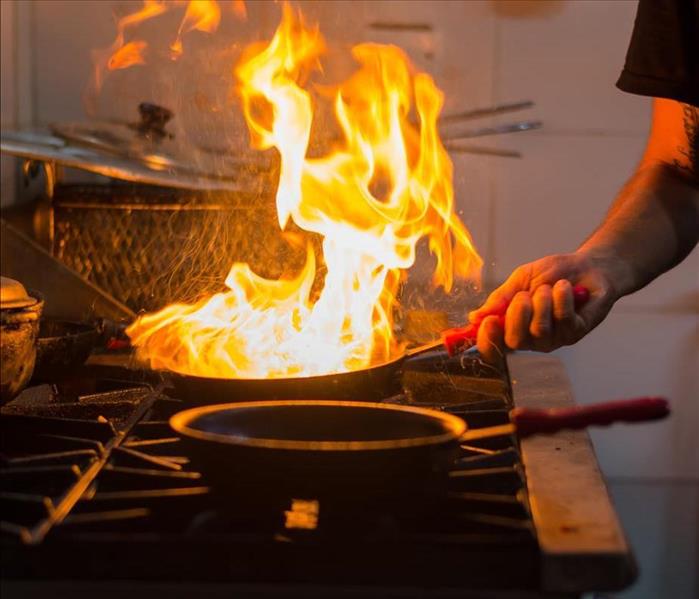 Developing an understanding of potential fire hazards in the kitchen and becoming aware of fire safety best practices are both ways to be prepared.
Developing an understanding of potential fire hazards in the kitchen and becoming aware of fire safety best practices are both ways to be prepared.
The kitchen is often a popular gathering spot year-round, but especially during the holidays. The National Fire Protection Agency reports that in 2019, Thanksgiving was the peak day for home cooking fires, followed by Christmas Day and Christmas Eve, which illuminates the prevalence of cooking fires during the holidays. Developing an understanding of potential fire hazards in the kitchen and becoming aware of fire safety best practices are two critical steps to take in order to help promote fire safety in the kitchen this holiday season. Keep reading for 3 proactive fire safety tips to keep in mind while cooking.
1. Create Space in Your Kitchen
The NFPA recommends creating a “kid-free zone” around certain dangerous areas of the kitchen in order to keep children away from cooking areas. However, this is a helpful tip for everyone spending time in the kitchen – not just children. Consider keeping at least 3 feet between guests in your kitchen and cooking equipment like stovetops and ovens.
2. Keep a Lid Nearby
The kitchen stove, according to the NFPA, is involved in the majority of kitchen fires. If a small fire ignites while cooking on the stove, it is beneficial to have a lid at arm’s reach, as it can facilitate the process of smothering the fire. By having a lid for your pan nearby, you can quickly reach for it, slide it over the pan, and turn off the burner upon first notice of a fire. This tip, however, is not helpful with oven fires. In the event of an oven fire, it is best to keep the oven door closed and the oven off.
3. Be Prepared to Handle a Fire
When you discover a fire in your kitchen, it is important to make a quick decision to either fight it or call for help. While action must be swift, your decision should be a thoughtful one. If you have any amount of doubt in your ability to sufficiently extinguish the fire, call 911, move everyone out of your home quickly and safely, and close the door behind you to prevent the fire from spreading. On the other hand, if the fire is small or if you have a fire extinguisher nearby and you feel confident in your ability to extinguish it, you may be able to handle it on your own. When in doubt, do not hesitate to call 911.
Call SERVPRO Team Wall for Residential Fire Damage Restoration
In the aftermath of any fire damage situation in your residential property, SERVPRO Team Wall has your back. Available 24/7 for professional residential Fire Damage Restoration services, Team Wall is here to help quickly restore your home to its preloss condition. For more information about the ways in which we can remove smoke odors, protect your fire damaged belongings, and rebuild fire-damaged structures, check out our website. Give our SERVPRO of Harrisburg West office a call at (717) 510-6779 today to learn more about our Fire Damage Restoration offerings. After any fire emergency, know that you can trust SERVPRO Team Wall to make it “Like it never even happened.”
Fire Safety With Heating Equipment
10/14/2022 (Permalink)
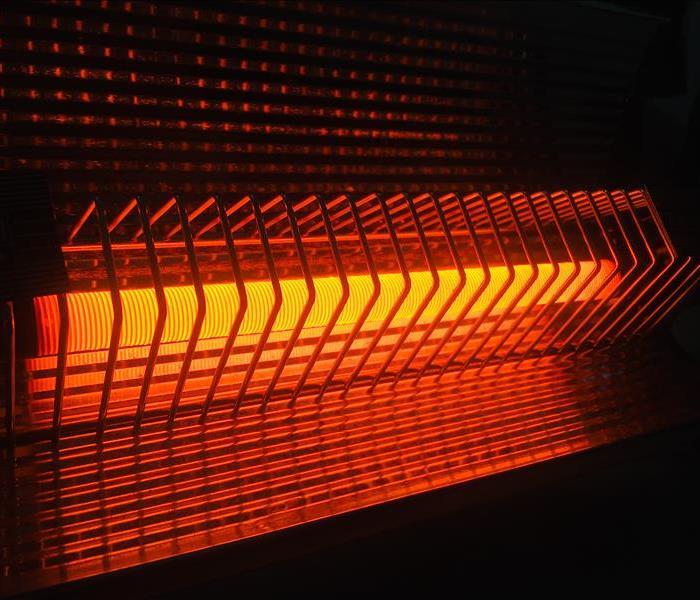 Whenever heating equipment is used, fire safety is important to discuss, as even small oversights can result in devastating accidents.
Whenever heating equipment is used, fire safety is important to discuss, as even small oversights can result in devastating accidents.
There’s a chill in the air, which means that it’s getting to be that time of year again when the temperature starts to drop and we start thinking about turning on our home or business’ heating system. Whenever heating equipment is used, fire safety is important to discuss because of the number of fires heating system malfunctions and accidents cause every year. By taking into consideration 3 statistical observations on the subject of heating safety risks from the National Fire Protection Agency, today’s blog will discuss a few different ways in which you can prevent your property from becoming part of the statistics.
An NFPA report on the subject of fire safety with heating equipment, based on annual averages between 2014 and 2018, found that…
1. “Most home heating fire deaths (81%) involved stationary or portable space heaters.”
Keep combustible objects like upholstery and blankets 3ft away from portable heaters in order to decrease fire risks.
2. “The leading factor contributing to home heating fires (25%) was failure to clean, principally from solid-fueled heating equipment, primarily chimneys.”
Solid-fueled heating systems like chimneys should receive annual, professional cleaning services. Having your chimney inspected and cleaned once every year can help decrease your property’s fire risk.
3. “Nearly half (48%) of all home heating fires occurred in December, January and February.”
During the winter, when the weather is cold, it can be easy to want to keep portable heaters turned on 24/7. When you leave the room or go to bed, turn off your portable heaters, as fires can ignite when heaters are unsupervised.
Call SERVPRO Team Wall for Fire Damage Restoration Services
You can find more Fire Tips, as well as more information about our Fire Damage Restoration services and Fire Restoration Process, on our website. This fall and winter, call SERVPRO Team Wall at (717) 510-6779 in the event that your home or business experiences fire damage this fall or winter. Trust us to make it “Like it never even happened.”
Fire Pit Fire Safety Tips
9/10/2022 (Permalink)
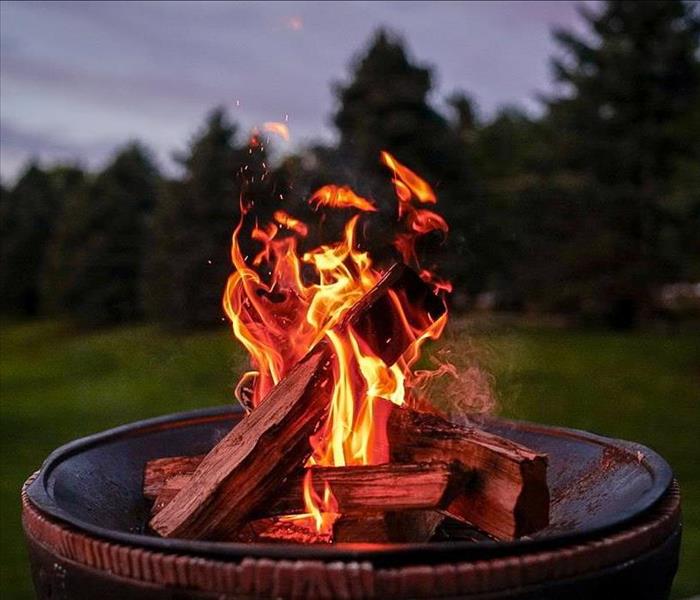 Focusing on fire safety when operating a fire pit this fall can help decrease the risk of unwanted fire damage.
Focusing on fire safety when operating a fire pit this fall can help decrease the risk of unwanted fire damage.
With summer heat still present in the September air, colder temperatures seems far off in our future. However, fall is right around the corner, which means that, alongside the s’mores, apple cider, and time spent outdoors that we associate with the season, fire pit season is also upon us. The National Fire Protection Association tells us that campfires and fire pits can cause accidents that may lead to injury. Today’s blog will share a few ways in which you can safely use a fire pit this fall, while avoiding fire damage to your property.
Fire Safety at the Fire Pit
There are two different types of fire pits: In-ground and above-ground. Regardless of which type you have on your property, it is always crucial to keep the fire pit situated a safe distance away from your home, as well as any other flammable objects, such as trees, brush, bushes, and sheds. Material is also important in reducing fire risk. Your property’s fire pit should be made of a non-combustible material, like heavy metal, brick, or stone. Lastly, whenever a fire is actively burning in a fire pit, a responsible adult should be present at all times in case the fire gets out of hand.
Make Safety a Priority
If your fire pit is not wood-burning, make sure that you follow the safety guidelines of your fuel type. Likewise, if you are using firewood, ensure that it is dry and clean. While these precautionary steps may seem trivial, they can have a tremendous impact on the safety of your property, as they can prevent fire emergencies. However, accidents happen, and that’s why it is beneficial to always have a fire extinguishing device on hand when using your fire pit. A fire extinguisher is a helpful tool, but a garden hose or bucket of water sitting nearby can also be a helpful tool that can quickly douse a fire if needed.
Have a Fire? Call SERVPRO
Focusing on fire safety when operating a fire pit this fall can help decrease the risk of unwanted fire damage. However, there are always fire risks and hazards present when igniting a fire in a fire pit. If your property experiences a fire emergency, SERVPRO Team Wall is available to your 24/7. Working diligently to restore your property to its preloss condition, our team of trained and experienced fire damage restoration professionals will make it “Like it never even happened” after fire emergencies large and small. For more information, call SERVPRO of Harrisburg West today at (717) 510-6779 or peruse our website, which features a plethora of our fire damage restoration resources, including our Fire Damage Restoration services overview, Fire Restoration Process, and Fire Damage Tips pages.
What To Avoid After a Fire
8/12/2022 (Permalink)
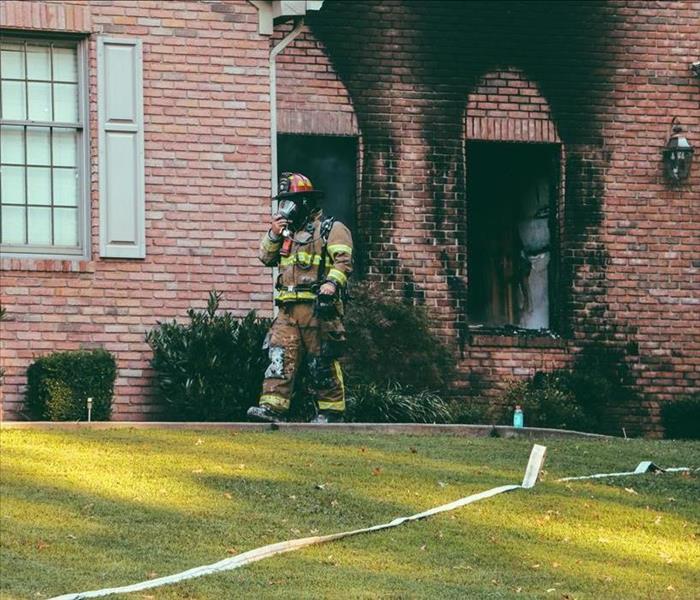 As a property owner, it is likely that after a fire, you are unsure of what you can do to facilitate the restoration process.
As a property owner, it is likely that after a fire, you are unsure of what you can do to facilitate the restoration process.
Residential and commercial fires alike disrupt daily life and operations and can be overwhelming for homeowners and business owners. As a property owner, it is likely that after a fire, you are unsure of what you can do to get things back to normal and facilitate the restoration process. While this is beneficial, productive thinking, it is important to remember that in the aftermath of a fire, additional damage can be inflicted upon the affected property. Keep reading to learn about three of the most important things to avoid after a fire so as to prevent any further damage to your property.
1. Re-entering Your Home or Business Before It Is Safe to Do So
Even though the fire may be extinguished, it does not mean that it is safe to re-enter the property. While you may be eager to get back inside and assess the damage, it is imperative that you acquire the fire department’s approval and clearance to re-enter. If you enter your property in the aftermath of a fire, there is increased risk for the property to sustain additional, unwanted damage.
2. Cleaning The Property Yourself
Smoke and soot residue can pose dangers to ceilings, walls, and other contents in the aftermath of large and small fires alike. Therefore, acquiring the help of a fire damage restoration professional for cleaning and removal is essential in order to prevent unwanted damage. A professional can help remove odors and ensure that any damage sustained during the fire is completely resolved. That being said, do not attempt to wash carpets or walls yourself either, as doing so can also risk unwanted damage. Contacting SERVPRO Team Wall is a surefire way to make sure that your property receives the expert services and care that it deserves to make fire damage “Like it never even happened” after an emergency, large or small.
3. Using or Cleaning Electrical Appliances
After a fire, it is important to refrain from using electrical appliances in order to protect yourself from electrical shock. Fires are extinguished using water, which may leave electrical appliances, including televisions, computers, refrigerators, and washing machines, wet and dangerous if operated. Likewise, attempting to clean electrical equipment, including light fixtures, after a fire is equally dangerous and should be left to professionals.
Call SERVPRO After a Fire
Picking up the phone and calling SERVPRO Team Wall at the first sign of fire damage is the best way to make sure that your property’s fire damage receives the best restoration and cleaning services, while preventing additional, unnecessary damage. To read more about our offerings, check out the commercial and residential Fire Damage Restoration Services, Fire Damage Restoration Process, and caring for your fire-damaged belongings pages on our website. Call SERVPRO of Harrisburg West at (717) 510-6779 to ensure that you are able to restore your property to its preloss condition and get things back to normal as soon as possible.
Fire Safety for Enjoying the Fireworks
6/23/2022 (Permalink)
 As reported by the NFPA, the number of fires started by fireworks exceeds 19,500 every year.
As reported by the NFPA, the number of fires started by fireworks exceeds 19,500 every year.
Fireworks and the 4th of July go hand-in-hand. In fact, fireworks are a summer staple, but they are not without their safety hazards. According to the National Fire Protection Agency, consumer fireworks, which are fireworks marketed to the public- not professionals-, are the reason behind thousands of injuries each year. When fireworks are handled and operated by people who are not professionals, potential consequences often include fires, devastating burn injuries, and even death. Before the 4th of July and your other firework-filled summer celebrations, it is important to be familiar with the safety risks associated with fireworks. Keep reading to learn more.
Fireworks and Their Fire Safety Hazards
As reported by the NFPA, the number of fires started by fireworks exceeds 19,500 every year. From this statistic, we can deduce that unprofessional fireworks threaten the safety of properties, both residential and commercial, in environments in which consumer fireworks are handled. Of these fires, the National Safety Council asserts that 1,300 are structural fires and 300 are vehicle fires. Both the NFPA and the NSC advise against home usage of fireworks and instead, they recommend that fireworks are left to the professionals. In order to partake in the summer tradition while keeping your home safe and ensuring the safety of people and properties in your surrounding area, consider attending a professional fireworks show or watching a televised show.
When Using Legal Fireworks…
While large consumer fireworks are generally illegal in our area, some consumer fireworks, like sparklers and firecrackers, are legal in Pennsylvania. Bear in mind that display fireworks are only legal to use for professionals with a permit. In the event that you choose to use legal consumer fireworks this summer, first consider these fire safety recommendations:
- Do not ignite fireworks indoors
- Children should never have access to fireworks without adult supervision. Even holding a sparkler can be dangerous, as they burn at 1200 degrees fahrenheit
- Have a bucket of water or hose nearby at all times while handling fireworks in case an unexpected fire ignites
- As soon as the fireworks finish burning, be sure to immediately and completely extinguish them by hosing them down or dousing them with water before disposal
Accidents happen. In the event that your home or commercial property endures fire damage this summer, pick up the phone and call SERVPRO of Harrisburg West at (717) 510-6779 as soon as possible. Check out the rest of our website to learn more about our Residential and Commercial Fire Damage Restoration services. After any fire emergency- large or small- trust SERVPRO Team Wall to make it “Like it never even happened” and restore your property to its preloss condition.
Summer HVAC Fire Safety
5/20/2022 (Permalink)
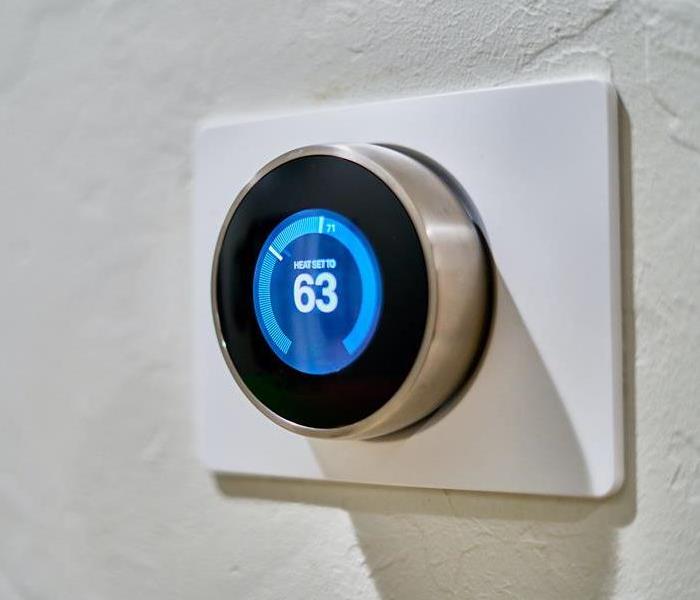 HVAC units can present fire hazards if they are not properly maintained.
HVAC units can present fire hazards if they are not properly maintained.
During the summer, your HVAC unit is meant to keep your home or business cool. However, HVAC units can present fire hazards if they are not properly maintained. In fact, HVAC fires can be devastating, so it is important to have your HVAC unit inspected and serviced regularly by a professional. In this blog, we’ll introduce you to three common causes of HVAC fires. With this information, you can be proactive and thereby protect your home or business from a fire emergency resulting from your HVAC unit this summer.
Overheated Motor
HVAC units can catch fire as a result of the unit’s motor overworking. As a result of an overworking motor, heat increases within the unit and can therefore pose a risk for a fire to ignite. A few different things can cause your HVAC unit’s motor to overheat. Dirt or debris surrounding the unit’s motor can act as an insulator, causing the motor to overheat. This situation can be avoided by ensuring that your HVAC unit is regularly cleaned. Additionally, your unit’s motor can overheat if there is either too much or too little voltage being applied to power the motor.
Electrical Issues
Another reason as to why your HVAC unit may catch fire is faulty wiring or electrical issues. Electrical connections tend to naturally loosen over time. Additionally, if frayed or corroding wires are not repaired in a timely manner, they can cause electrical shorts, from which a fire might ignite. You can prevent this by scheduling regular HVAC unit inspections and making sure that wires are replaced when necessary in order to avoid electrical complications.
Leaking Fuel Line
A third cause is leaking fuel lines, which can lead to gas leaks. Gas coming into contact with heat is likely to result in a fire. If you smell gas in your home or business, especially in close proximity to your HVAC unit, it is important to treat the situation seriously.
We Are HVAC Professionals
Trust the HVAC professionals at SERVPRO Disaster Recovery Team - Team Wall to thoroughly inspect and effectively service your HVAC unit. In order to most effectively maintain your HVAC unit and prevent fires, it is recommended that homeowners and business owners have their HVAC units inspected on a biannual basis by an HVAC professional. For more information about our HVAC Cleaning, Fire Damage Restoration, and general Cleaning services in case of an emergency, visit our website. You can also call your local SERVPRO Team Wall office, SERVPRO of Harrisburg West, at (717) 510-6779.
Decreasing Pesky Odors After a Fire
3/24/2022 (Permalink)
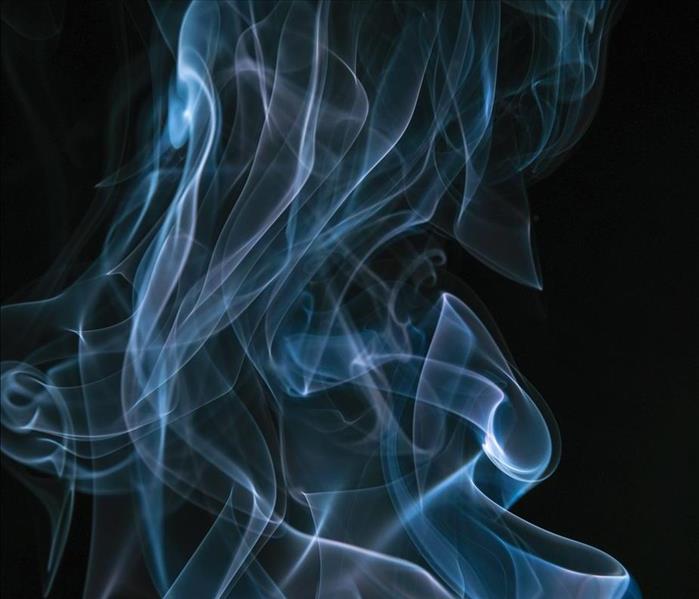 Smoke particles and their odor linger long after their fire goes out.
Smoke particles and their odor linger long after their fire goes out.
Chances are, you’ve either experienced a small fire in your kitchen that left the area with a strong smell for a little while or, you’ve come back inside after a campfire only to discover a powerful, smokey odor on your clothing. Smoke particles and their odor linger long after their fire goes out. In order to get rid of that unpleasant odor as soon as possible after a fire, consider these three actions you can take before professional help arrives:
3 Steps You Can Take to Decrease Odors After a Fire
If your property has windows or doors that can be safely opened or propped open, this is an effective first step. Opening windows and doors ushers in outside air and will help increase airflow and circulation in the affected area. You may not immediately think of replacing air filters after a fire, but it can also be beneficial in minimizing the spread of smoke particles. Lastly, deep cleaning can also be effective in preventing smoke particles from lingering on surfaces. When cleaning, be sure to target hard surfaces, windows, and upholstery, as smoke particles can adhere to many different types of surfaces. Scrubbing those kitchen counters and windows, as well as washing pillowcases and blankets, can make a significant difference.
SERVPRO Is Here to Help
All the while, these actions can help but they are not enough to completely eradicate smoke odors after a fire. Additionally, your residential or commercial property requires professional odor removal services. Our team members are highly trained in deodorization and utilize state-of-the-art cleaning equipment and products in order to identify and eliminate odors. Our top priority is always making it “Like it never even happened,” which means that SERVPRO Disaster Recovery Team - Team Wall is committed to getting the job done thoroughly and quickly so that you can get back to the important things. Call us at (717) 510-6779 or visit our website for more information about our renowned Odor Removal, Fire Damage Restoration, Commercial Fire Damage Restoration, and Fire-Damaged Contents Care services. Trust SERVPRO and our restoration, construction, and cleaning expertise to restore your property to its preloss condition after any emergency.
3 Safety Tips to Remember When Cooking
3/4/2022 (Permalink)
 Gaining a deeper understanding of kitchen fire safety and techniques can decrease your risk of sustaining fire damage from a kitchen fire.
Gaining a deeper understanding of kitchen fire safety and techniques can decrease your risk of sustaining fire damage from a kitchen fire.
The National Fire Protection Agency reports, “the leading cause of fires in the kitchen is unattended cooking.” Further, they clarify that kitchen stoves are usually involved in cooking fires. It is impossible to completely rule out the possibility of an unwanted fire igniting when cooking, but gaining a deeper understanding of kitchen fire safety and techniques can decrease your risk of sustaining fire damage from a kitchen fire. In this blog, we’ll share and elaborate upon 3 of the fire safety tips recommended by the NFPA.
1. Don’t Stray Too Far from the Kitchen
Depending on the nature of your cooking activity, there are actually different guidelines concerning your recommended proximity to the kitchen. In the event that you are actively boiling, grilling, broiling, or frying, the NFPA recommends that you stay in the kitchen for the duration of the activity in order to effectively monitor the cooking area. It is best to turn the stove off in the event that you must leave the kitchen. If your cooking activity, on the other hand, is baking, simmering, or roasting, it is O.K. to leave the kitchen if necessary, but it is strongly advised that you stay inside of your home in case of emergency until you’re finished. In this circumstance, be sure to either set a timer or check in on whatever you’re cooking frequently in order to prevent an unintentional kitchen fire from igniting.
2. Know What to Do When an Oven Fire Occurs
The protocol for stove fire is widely-known, but what about oven fires? Fires can, in fact, ignite inside of your oven. If you notice an unexpected fire in your oven, the NFPA advises that you immediately turn off the heat and refrain from opening the oven door until the fire completely extinguishes. This will prevent the fire from spreading.
3. Keep Your Cooking Area Clear of Flammable Objects
It may come as a surprise to know that, within cooking areas, you can usually find a host of flammable items. Towels, oven mitts, and wooden utensils are just three examples of such commonplace, flammable objects. If an unwanted fire ignites in your cooking area, having flammable objects stored in a close proximity can increase the risk of the fire growing and spreading to other areas, leaving you with not only a larger fire to extinguish, but also a greater chance of fire damage. Make sure that you keep flammable objects safely tucked away in drawers or cabinets.
Experienced a Fire? Call SERVPRO
If your home or business has experienced an unwanted kitchen fire or a fire of any kind, be sure to call SERVPRO of Harrisburg West right away at (717) 510-6779. Trust our slogan, which states that we make fire damage “Like it never even happened.” You can also receive more information about our fire damage restoration services, which includes both our residential Fire Damage Restoration services and Commercial Fire Damage Restoration services, in addition to supplemental fire-related services, such as Odor Removal and Deodorization, by visiting our website. You can also find some of our personal favorite Fire Damage Tips on our website.
Classifications of Fire Extinguishers For Home Use
12/10/2021 (Permalink)
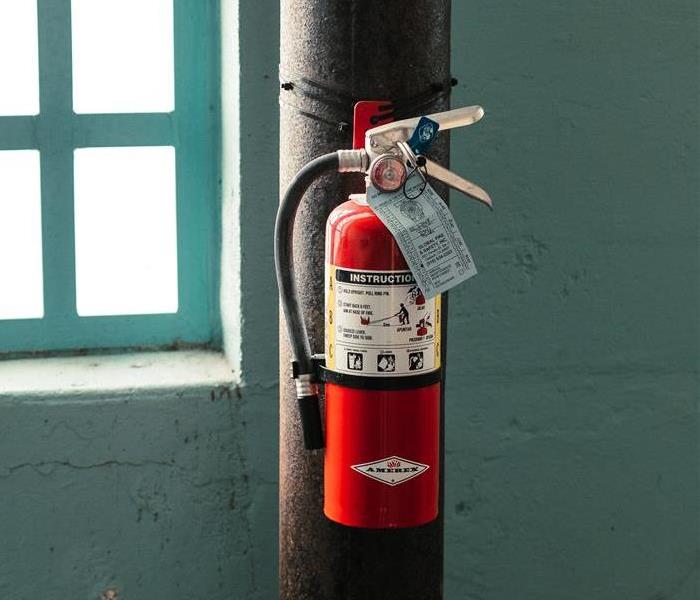 While we tend to think of fire extinguishers as a necessity for commercial properties, they can also be beneficial in home fire safety as well.
While we tend to think of fire extinguishers as a necessity for commercial properties, they can also be beneficial in home fire safety as well.
Whenever you visit a store or commercial building, a fire extinguisher typically isn’t terribly difficult to find. How often, however, do you see a fire extinguisher when visiting the homes of friends and family? While we tend to only think of fire extinguishers as a necessity for commercial properties, they can also be beneficial in homes and other types of residential properties. You may be wondering: “what kind of fire extinguisher is best for my home?” There are several different classifications of fire extinguishers made for various types of fires. Keep reading for a run-down of the three primary fire extinguishers classifications that offer the most benefits to residential properties.
- Class A Fire Extinguishers
The first class of fire extinguishers beneficial to homes is Class A. These types of fire extinguishers work to put out fires ignited by household flammable objects such as paper, wood, and cloth. If purchasing a Class A fire extinguisher, it would be most effective when kept in your living room and another common area.
- Class B Fire Extinguishers
For fires started as a result of combustible liquids, including propane, grease, and gasoline, Class B is the way to go. It is best to store Class B fire extinguishers in workspaces such as workshops, sheds, and garages, as this is where the majority of fires resulting from combustible liquids ignite.
- Class C Fire Extinguishers
Lastly, Class C fire extinguishers combat electrical fires. Often, these kinds of fires are sparked by malfunctions in electrical equipment, appliances, and tools of different kinds. Keep this kind of fire extinguisher in the vicinity of wherever the most electrical appliances are used, such as kitchens or workshops.
Multipurpose Fire Extinguishers
If your home’s needs require coverage for more than one of the classifications listed above, you’re in luck. Multipurpose fire extinguishers, which combat certain combinations of these classifications or all three of them, can be purchased at most hardware stores, listed as A-B, B-C, or A-B-C. These multipurpose fire extinguishers are recommended for homeowners, according to the National Fire Protection Agency, because of their versatility.
Fire Damage? Call SERVPRO
It should be understood that fire extinguishers are not appropriate, thorough line of defense in every fire emergency. While fire extinguishers can be effective in smothering small, easily-containable fires, they cannot safely combat larger fires. Instead of grabbing the fire extinguisher in a large fire emergency, grab anyone living in your home and make your top priority getting everyone out safely. Let SERVPRO take it from there. Call your local SERVPRO Disaster Recovery Team - Team Wall office, SERVPRO of Harrisburg West, at (717) 510-6779. Let our 24-Hour Emergency Services, in addition to our crews’ extensive knowledge and advanced technologies, put your mind at ease. Check out our website for more information about our Fire Damage Restoration services. We also offer Commercial Fire Damage Restoration services, which are tailored to the specific needs of commercial properties. Additionally, we are able to restore your property to its pre-fire loss condition through our odor removal and deodorization services and the careful attention that we give to your fire-damaged belongings. Even when armed with a fire extinguisher, fire emergencies can still occur. In the event that your residential or commercial property experiences a fire, trust SERVPRO Team Wall to make it “Like it never even happened.”
Winter Fire Safety: Fireplaces
12/3/2021 (Permalink)
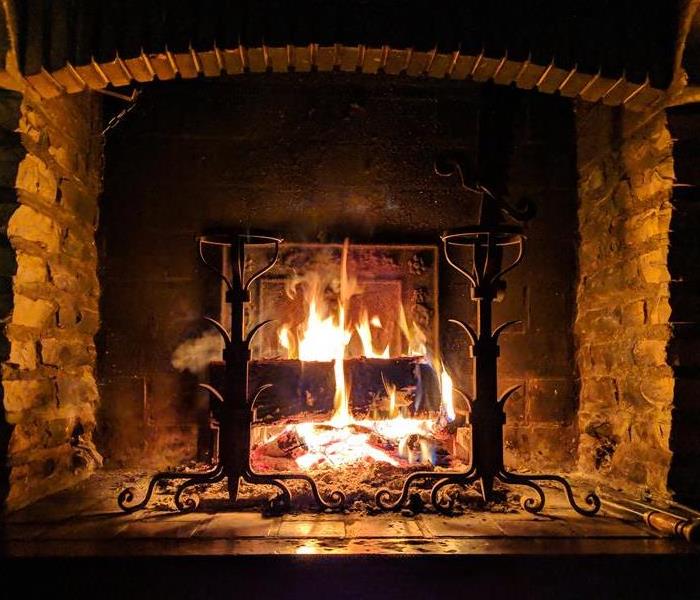 The American Red Cross reports the involvement of heating equipment in “1 of every 6 home fires.”
The American Red Cross reports the involvement of heating equipment in “1 of every 6 home fires.”
As we enter December and begin to really feel a temperature change in the Harrisburg area, fireplaces can provide a much needed source of warmth. While they’re helpful in making our homes cozy, fireplaces can also be fire hazards if utilized unsafely. Keep reading to learn more about ways in which you can protect your home from fire damage stemming from your fireplace this winter.
Overview of Fireplace Statistics
The American Red Cross reports the involvement of heating equipment in “1 of every 6 home fires.” Additionally, they state that during the winter season, from December to February, the most heating equipment-induced residential fires and deaths occur, as “1 in every 5 home fire deaths and half of all fires caused by home heating occur” in that time frame. These statistics are alarming and you might be wondering what it is that causes heating equipment complications to instigate such devastation. According to the Environmental Protection Agency, “The leading factor contributing to home heating fires was failure to clean, principally creosote from solid-fueled heating equipment, primarily chimneys,” a statement supported by the National Fire Protection Agency. 87% of heating equipment fires in residential buildings, as reported by the EPA, result from fireplaces. From these statistics, it is easy to deduce that fire safety in the presence of fireplaces is critical in preventing unwanted fire damage in your home.
“So, What Can I Do?”: Chimney Fire Prevention
In this section, we’ll share a few preventative measures against fire hazards that you can take as a homeowner. It is recommended that flammable objects and materials like wrapping paper, clothing, and newspapers, which the Red Cross refers to as “fuel” for fires, should never come closer than 3 feet away from your fireplace. Additionally, you can utilize a fire screen whenever your fireplace is in use, as it keeps embers and sparks from escaping your fireplace. When you’re getting ready to turn in for the night, be sure to thoroughly extinguish your fire. Having a professional check and clean your fireplace once per year is another step recommended by the Red Cross in an effort to protect your home from an unforeseen fireplace emergency. Installing smoke and carbon monoxide detectors is another step recommended by the Hearth, Patio & Barbeque Association in addition to having a fire extinguisher on hand in your home in the event that a fire ignites unexpectedly.
What To Do If Your Fireplace Instigates a Fire
Fireplace fires aren’t supposed to escape the fireplace, but in the event that they do, know that SERVPRO Disaster Recovery Team - Team Wall has seen it all and will respond immediately when you contact us. Pick up the phone and call our Harrisburg West office at (717) 510-6779 after any size fire damage emergency. No matter the type or scope of the fire damage, our team of skilled and experienced fire damage specialists will be there to restore your home to its preloss condition. We offer a wide array of services, from Fire Damage Restoration and Water Damage Restoration to Cleaning and deodorizing services. You can also find Fire Damage Tips on our website for more information about what to do before help arrives. This winter, take comfort in the fact that SERVPRO Team Wall has your back and is always ready to make your home’s fire damage “Like it never even happened.”
Large Loss Commercial Fire Damage: Job of the Quarter
10/8/2021 (Permalink)
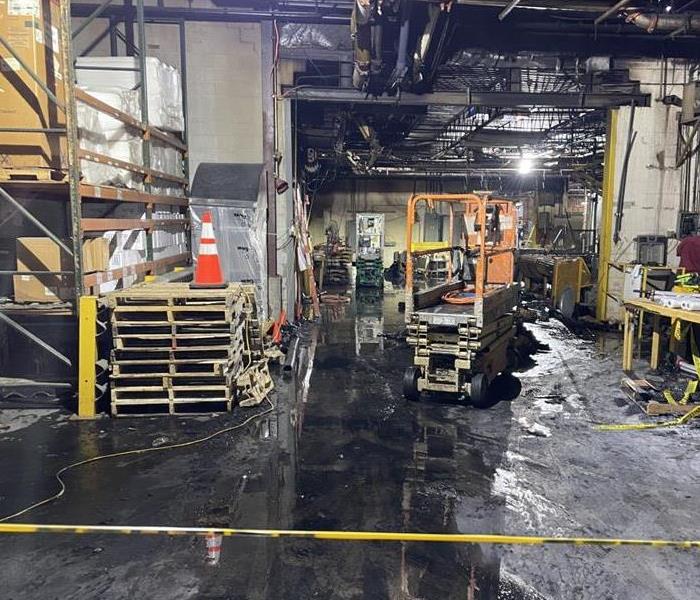 The large fire in our customer's warehouse left behind about 170,000 square feet of space affected by soot and smoke
The large fire in our customer's warehouse left behind about 170,000 square feet of space affected by soot and smoke
We take the time here at SERVPRO Disaster Recovery Team - Team Wall each quarter to select one job as our “Job of the Quarter.” For this special title, we select a particular job that spotlights the strengths of our company and the goals for which we strive in every job that we have the pleasure to complete. For 3rd Quarter 2021, our “Job of the Quarter” title goes to our work in July with a customer who experienced fire and smoke damage within their warehouse. Members of our team from every department and every corner of our company came together to get the job done with our trademark hustle and teamwork.
A Large Loss Is Never Too Large
Our customer reached out to us on June 28th with information about a large fire loss that they had experienced on their commercial property. We arrived on site as soon as possible with our Harrisburg West team of professionals ready to assess the damage within 24 hours. With our 24-Hour Emergency Services, our ability to complete both restoration and reconstruction work, and experience working on large loss projects, we were able to prove to our customer that we could get their commercial business back on track in no time.
Making It “Like it never even happened.”
The large fire in our customer's warehouse left behind about 170,000 square feet of space affected by soot and smoke, made worse due to the fire’s proximity to the building’s HVAC unit. Work began on the same day the contract was signed, as we wanted to get a head start on tarping the roof and cleaning ducts. Working through the July 4th holiday weekend in order to get our customer's employees back in their building quickly, we cleaned offices while employees were not in the building, therefore reducing distractions. 40 or more crew members made up our team and worked around the clock. Additionally, the job required us to rent a scissor lift so that we could reach high ceilings impacted by smoke and soot damage. Another challenge involved planning our work around the customer's daily production schedules, as it was not feasible to halt production while we worked. We overcame this challenge by coordinating schedules and sectioning off specific areas in which we were working so that the company’s daily operations could carry on throughout the process. Our final walkthrough of the facility was completed on July 26th- just 22 days after work began.
Teamwork Makes All The Difference
What makes this specific job deserving of our “Job of the Quarter” title is the way in which this job exemplified our emphasis on teamwork. From our digital marketing team that got our foot in the door to the crew members working on the job site, everyone had a hand in our success. Jannene Miller, one of our commercial account managers, served as the primary point of contact for our customer and kept them up to date through regular communication. Jim Wall, one of our owners, alongside Jason Quick, our Harrisburg West Vice President of Operations, and George Readinger, who serves as our team’s Large Loss Production Manager, traveled to the job site in order to communicate with the customer. Back in the office, owner Trish Wall helped seal the deal by sending letters of recommendation. SERVPRO Disaster Recovery Team - Team Wall is truly a team, as members from every area of our company work together to make our customer’s large fire loss “Like it never even happened.” Our teamwork made it possible for us to ensure that our customer was content with every stage of the restoration process in addition to the final product.
Have a Large Loss? Call Team Wall
Regardless of the nature of your commercial business’ large loss damage, SERVPRO Disaster Recovery Team - Team Wall can help. Our commercial restoration services specifically target fire, storm, water, and mold damage. If your business is looking for a team of large loss restoration professionals with advanced equipment, look no further than SERVPRO. While we hope that your commercial business is never faced with a large loss of any kind, know that we are always standing by and looking forward to help after any emergency.
Cleaning Your HVAC System Following a Fire
9/2/2021 (Permalink)
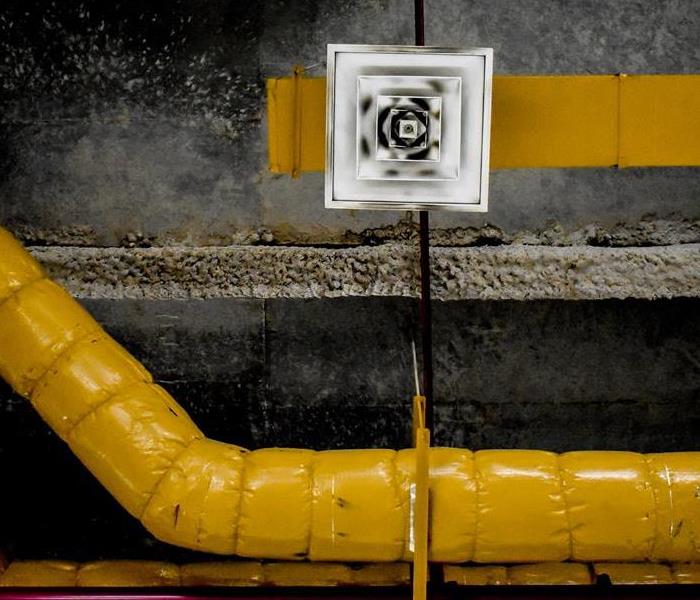 Fires can negatively impact HVAC units, which work to facilitate airflow throughout your home or business.
Fires can negatively impact HVAC units, which work to facilitate airflow throughout your home or business.
Damage to your property’s structure and contents are usually at the top of the list of concerns after a fire. What you may overlook, however, is the crucial behind-the-scenes equipment that keeps your property safe, such as your HVAC system. Fires can negatively impact HVAC units, which work to facilitate airflow throughout your home or business. Therefore, HVAC systems can actually have a hand in exacerbating health effects to those working or living in the property, as they can carry air contaminated with smoke or soot residue throughout the affected home or business. As a result, HVAC system cleaning is essential after a damaging fire and fortunately, we offer professional HVAC cleaning services on our list of Cleaning Services here at SERVPRO, which can help your home or business return to normal as quickly as possible.
When Should HVAC Cleaning Be Implemented?
HVAC cleaning services are most frequently implemented after fires that give rise to moderate to heavy amounts of smoke or soot residue. It is also important to consider the proximity of the fire to your property’s HVAC unit when determining whether HVAC cleaning is necessary. In any circumstance, recruiting a knowledgeable and experienced HVAC and fire cleaning professional to inspect the affected areas and determine the severity of the fire damage. Duct sealing services, in which soot and dust particles are vacuumed and vent registers and air intakes are removed, cleaned, and replaced, are another variety of HVAC unit cleaning that we provide in the event that your property’s unit cannot be cleaned normally. Here at SERVPRO of Harrisburg West, we have experts in both HVAC cleaning and fire damage restoration on our team who will make certain that your property receives the most appropriate services.
HVAC Cleaning Reduces Health Effects
One of the most important benefits of implementing HVAC cleaning services in your home or business after a fire is the prevention of various health effects presented by fires. When your HVAC unit is professionally cleaned, the smoke and soot particles lingering in your home or business are removed, therefore decreasing the risk of respiratory issues and poor air quality.
For Professional HVAC Cleaning, Call SERVPRO
In the event that your home or business experiences a fire of any magnitude, call SERVPRO of Harrisburg West right away at (717) 510-6779. You’ll immediately receive the help of our seasoned fire damage restoration and HVAC cleaning specialists, in addition to our professional equipment. Read more about our reputable Fire Damage Restoration services, as well as our tried-and-true Fire Restoration Process on our website. Additionally, through our Air Ducts and HVAC Cleaning services, our team is committed to eliminating further damage after your property’s fire. For a thorough and quick recovery after any fire damage emergency, don’t wait- call SERVPRO today.
Preventing Lithium Battery Fires
8/13/2021 (Permalink)
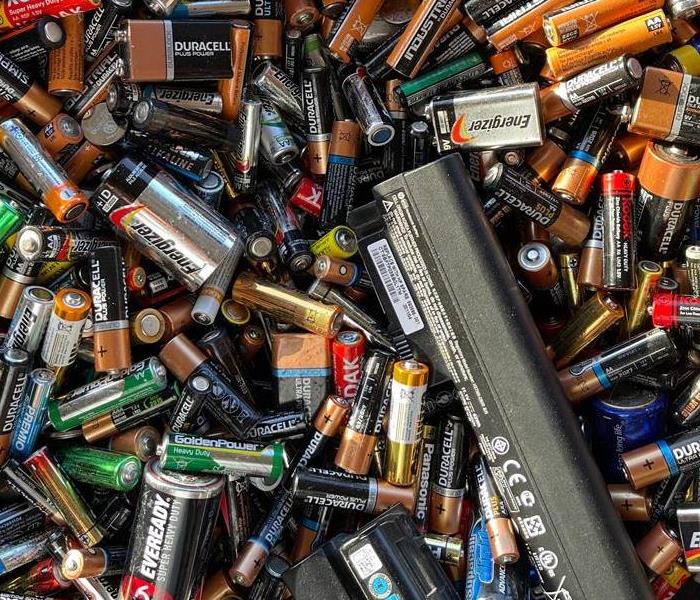 Due to the increase in the presence of lithium batteries in our lives, it is important to understand that fire safety concerns can accompany them.
Due to the increase in the presence of lithium batteries in our lives, it is important to understand that fire safety concerns can accompany them.
In chemistry class, you may have first been introduced to lithium as the third element on the periodic table. Beyond the periodic table, however, lithium serves many different purposes, such as its function in batteries, providing portable energy to various types of electronics. There are lithium batteries as well as lithium-ion batteries and the difference between the two lies in the type of cell. It is not possible to charge lithium batteries, as they are primary cells, but lithium-ion batteries, which are secondary cells, can be recharged. You may not be aware of it, but chances are you use an electronic device regularly that is powered by either type of lithium battery. Due to the increase in the presence of lithium batteries in our lives, it is important to understand that certain fire safety concerns accompany them if they malfunction or endure damage. With a thorough understanding of the risks that accompany lithium batteries, you can protect your home or commercial business.
Why Are Lithium Batteries Such a Concern?
Even though lithium batteries can be a fire hazard, they are still put to use in our daily lives. This is because most of the time, it is safe to utilize lithium batteries, as they only become hazardous in the event that they overheat or short-circuit. Lithium-ion batteries in electronic devices often release overwhelming heat when they reach their maximum temperature, which can result from overcharging or overheating. Fires can occur under these circumstances, evident in news reports from the last several years that share concerning stories of hoverboards and cell phones igniting. However, lithium batteries are not as hazardous as such stories say they are. Categorized as Class 9 hazards according to the United States Postal Service, lithium batteries are acknowledged as miscellaneous hazardous materials, which only present hazards during transportation.
Preventing Lithium Battery Fires This Summer
It’s not difficult to find lithium batteries and lithium-ion batteries in your day-to-day life, as they are often used to power everything from laptops and cell phones to electric toothbrushes. Practicing fire safety when using lithium battery or lithium-ion battery-powered devices can protect your home or business from fire damage this summer. The summer is a critical time to learn how to prevent a fire resulting from lithium batteries, as the likelihood of portable electronics overheating naturally increases in the sizzling heat. Making sure that electronics are not left in hot cars for long amounts of time and avoiding charging in the heat can therefore decrease the chances of a fire igniting. Utilizing a trustworthy, reputable charger and investing in a high-quality phone case can also make a significant difference in protecting its battery and preventing a fire resulting from malfunctioning lithium batteries.
Have You Experienced Fire Damage? Call SERVPRO
Even though lithium battery fires do not occur frequently and do not regularly pose threats to safety, fires can occur. Therefore, having an emergency plan in place is beneficial. This is where we step in to help. Here at SERVPRO of Harrisburg West, we strive to be ready for anything. When an unexpected fire ignites in your home or commercial business, you can trust SERVPRO to provide the Fire Damage Restoration Services and Commercial Fire Damage Restoration Services that you need. At the first sign of damage, call us at (717) 510-6779 in order to prevent any further damage. Check out our website to learn more about our Fire Restoration Process, including our specific offerings such as Caring for Your Belongings, which can facilitate the cleanup process in the event that a fire impacts other objects in your home or business, including electronics, photographs, and documents. Regardless of whether your home or commercial business’ fire is ignited due to lithium batteries or another source, know that SERVPRO is standing by with our 24-Hour Emergency Service, ready to help make it “Like it never even happened.”
An Overview of Matterport
6/25/2021 (Permalink)
When it comes to capturing 3D spaces in a variety of industry sectors, Matterport is second to none. They set the precedent for both indexing and digitizing our world in terms of building and spatial data. Using the 3D data platform provided by Matterport, anyone can transform a physical space into an immersive and exact digital copy. Any space can then be built, designed, operated, promoted, and ultimately, better understood using this technology.
How Does Matterport Help Our Clients?
Accuracy and velocity are the two critical elements of Matterport technology that are of advantage to both our customers and insurance professionals in the industry. In the past, we have had to rely on camera phones and our own hands to measure a property and take note of damage. However, with the help of Matterport, the process is much simpler and the margin of human error falls within just 1%, as our team is now capable of taking measurements and photographically documenting damage at the same time by utilizing Matterport. Additionally, Matterport eliminates bias because it is impossible for any party to manipulate the 3D space that the technology generates. This efficient technology facilitates the process of claim settlement, decreasing the amount of time that it takes for our crew to restore the property to its preloss condition and making it “Like it never even happened,” for our customers.
Matterport In Action
Overcoming Pandemic Obstacles
Preventing field adjusters from arriving on the job site, the COVID-19 pandemic complicated various aspects of the remediation process. As a result of this limitation, adjusters had to navigate unpredictable situations. SERVPRO Disaster Recovery Team- Team Wall was able to ease their minds through Matterport technology, as well as our excellent services provided to the clients that we share.
Faster to the Finish Line
Following an incident of structural damage to the roof of a multi-family condominium, an engineer was called in to assess and dictate required repair work. His job became significantly easier when he learned that SERVPRO Team Wall had already utilized Matterport to scan the property, as this allowed him to build a thorough report based on our 3D scan. In this way, the report was completed faster, which helped our team to get to work on repairing the structure and reducing the project’s turnaround time.
Caring for Your Belongings
When a client’s residential property suffered a fire, we depended on Matterport to catalog the extent of the damages to structure and personal belongings. The client, due to her health, was not able to spend much time onsite. Despite this obstacle, we were able to keep her updated on the job by conducting multiple scans of the property. With Matterport’s help, she was also still able to have a hand in our team’s process of inventorying non-salvageable items.
SERVPRO and Matterport Are Here To Help
Our primary goal here at SERVPRO of Harrisburg West is to provide superior customer service. Matterport and other forms of state-of-the-art technology assist us in improving our residential and commercial property restoration processes everyday. For more information about Matterport and SERVPRO Disaster Recovery Team – Team Wall, call us at (717) 510-6779. You can also learn more about what we do by checking out our website, which details our fire, water, mold, and storm restoration services. On our website, more information can also be found about our other Advanced Technologies. Trust the combined resources of SERVPRO of Harrisburg West and Matterport to provide efficient and thorough restoration services for your home or commercial business, getting your life back on track as soon as possible.
A Guide to Electrical Outlet Safety
5/12/2021 (Permalink)
It’s a common dilemma that we have all faced at one point or another: Standing perplexed, holding an electrical cord in our hands, questioning whether it is safe to plug in. Would one more plug in the outlet make that much of a difference? The reality is, the consensus on electrical outlet guidelines are blurry, prompting poor decisions that could result in an electrical fire. Electrical malfunctions, according to a study conducted by the National Fire Protection Agency in 2012 and 2016, were the second leading cause of residential fires. So, how many cords is too many? In order to be sure that you are taking every precaution to prevent an electrical fire from igniting in your home, keep reading.
Statistics About Electrical Fires
It is important to first understand the most common reasons as to why electrical fires ignite in homes. A 2018 report on Residential Building Electrical Fires published by FEMA found that from 2014 to 2016, one of the first items to catch fire in homes during electrical fires is electrical wire. 12 percent of electrical fires involved outlets and receptacles, while 5 percent stemmed from extension cords. In light of this information, it is crucial that we navigate outlets, cords, and electrical wires carefully.
Guidelines
In the FEMA report, a long list of guidelines related to fire safety when utilizing appliances, outlets, and extension cords is provided.
Appliances
FEMA reports that appliances, including refrigerators, washing machines, and microwaves, must be plugged into wall outlets instead of indirect, alternative power sources. It is also recommended that appliances’ wires and electrical cords be surveyed on a regular basis for possible damage, which may include loosening or cracking, in order to decrease the chances of an unexpected electrical fire.
Outlets and Extension Cords
Extension cords provide a quick solution when we have more to plug in than what an outlet can handle. However, this renders extension cords even more hazardous, which emphasizes the importance of never overloading an extension cord. Usually, you should be able to find an extension cord’s capacity on its packaging. Extension cords with internal overload protection are recommended. Similarly, wall outlets should not be overwhelmed with a greater number of plugs than there are outlets available. Additionally, two-prong outlets should not be utilized for three-pronged electrical cords.
Where SERVPRO Can Help
It is possible for homes and residences to fall victim to electrical fires as a result of accidents, even when precautionary measures are taken. This is where SERVPRO of Harrisburg West steps in. We are standing by, ready to lend a hand in the event that your home endures an unexpected electrical fire. Know that our professional fire services are designed to mend your fire-damaged residence, restoring it to its previous condition. Check out our website to learn about more of our fire-related services, including our Fire Damage Tips and Fire Restoration Process. Don’t wait. Pick up the phone and call SERVPRO of Harrisburg West at (717) 510-6779 for our trusted residential fire damage restoration services.
Invasive Smoke Damage: Here’s What To Know
3/29/2021 (Permalink)
In terms of emergencies in homes and businesses, it’s common knowledge that fires can be incredibly destructive. Lurking alongside fires, however, is often an invisible concern that can be just as harmful as fire damage: Smoke damage. Smoke is an invasive substance, sometimes requiring greater restoration services than one would expect. Let’s take a closer look at the nature of smoke damage in order to get a better idea of the effects it can have on your home or business.
Why Is Smoke Invasive?
Smoke can infiltrate even the smallest cracks or crevices. When homeowners or business owners attempt to get rid of soot particles, the substance only smears. Drywall, which is porous in nature, is another easy target for smoke. For this reason, smoke can make its way into insulation and in this case, demolition is often required in order to eliminate the odor of the smoke. Smoke damage also varies in severity depending on the kind of contents that are affected, as well as their location in relation to the source of the smoke.
Surprising Effects of Smoke Damage
In the wake of a fire, physical residue resembling the shape of spider webs can be left behind. These aren’t actual spider webs, but they may still be a cause for concern. What you see on your walls and ceilings are webs made up of smoke. Other times, the presence of smoke damage is not visible. When a protein burns, the resulting “protein fire” does not mark its presence with the soot or dark smoke that we often associate with fires. In the absence of visible damage, homeowners and business owners often wonder why the smoke odor will not go away. Another effect of smoke damage that is important to consider is the acidic quality of soot, which can therefore cause metal substances to corrode. Over time, this can be detrimental to your home or business.
Why Is Demolition Necessary?
Because smoke damage does not always leave a trail of visible damage, it can be difficult to understand the need for demolition and rebuild work after a fire. If your home or business experiences significant fire damage, demolition is often necessary in order to provide a thorough cleaning and restoration. Scrubbing surfaces is not enough when it comes to eliminating smoke odor. Cracks and crevices are the favorite hiding places of smoke and soot, as they commonly nestle themselves in the gaps between plaster or drywall and interior firewall. Additionally, smoke odor tends to hide in insulation and other areas, returning in full force the next time the weather is hot and humid. Even with intense scrubbing, without demolition, it is almost as though the smoke was never cleaned.
How Do We Combat Invasive Smoke Damage at SERVPRO?
Our first priority when combating smoke damage is removing materials that are charred or burned from the home or business. We also tend to “chase” the smoke, which involves surveying any open areas in which the smoke may have traveled in order to track its spread. This process helps us in identifying and thoroughly inspecting every area in your home or business that has been impacted by smoke. Next, we dive into the remediation work. It is not uncommon for water to accompany smoke damage, so we utilize our specialized tools and equipment in order to complete the water extraction. We also work to remove the smoke odor by placing equipment around that home. Lastly, after demolition and cleaning work is complete, we apply a sealant, which works to encase any smoke odor that remains in hard-to-reach areas, such as small crevices.
Trust SERVPRO with Smoke Damage
Because of the invasive nature of smoke damage, it is critical that you call SERVPRO of Harrisburg West at (717) 510-6779 immediately if your home or business has been affected. You can trust our team of smoke damage professionals and reputable techniques to get the job done. We offer a wide array of services, ranging from contents cleaning to deodorizing services, that will work to eliminate smoke and soot from every kind of surface. While our Fire Damage Restoration services are well-known, we also provide a laundry list of Building Services that make us capable of taking care of your home or business’ restoration and rebuild projects alike. To learn more about the Building Services that we offer, click here. There’s no need to look anywhere beyond SERVPRO in the event that your home or business is impacted by a fire. We are standing by 24/7, prepared to make your smoke damage “Like it never even happened,” by having your back throughout the fire and smoke damage restoration, demolition, and rebuild processes.
Fire Damage Curtains? Here's What to Do.
3/3/2021 (Permalink)
The fierce blaze of a fire is capable of creating intense destruction in homes and businesses alike. Fires can make their mark by damaging everything from furniture and personal belongings to the overall structure of the building. For this reason, it is critical that fire damage is avoided in every way possible by acting immediately after the fire has been extinguished. You’ve likely seen articles about different ways to clean surfaces after a fire on the internet or in magazines. However, you may be wondering, what should I do with fire-damaged textiles? Fabrics and curtains in particular, which can be found throughout homes and businesses, are flammable and can easily sustain fire damage. The good news is that you shouldn’t take fire damaged curtains to the garbage bin just yet. They might just be salvageable with professional cleaning. Let’s walk through some ways in which you can care for your curtains after a fire:
How to Care for Fire-Damaged Curtains
Two types of damage can result from a fire: smoke damage and soot damage. Your curtains may have experienced one or both and each type requires unique cleaning processes.
Smoke Damage
In order to effectively combat smoke damage to curtains following a fire, it is crucial to first eliminate the odor. If enough time passes before the odor is removed, it may become trapped in the fabric, which can further damage the curtains. You can trust SERVPRO and our professional deodorizing treatments to get the job done. As soon as the smoke odor is removed, we can get to work cleaning your curtains, utilizing our Drapes and Blinds Services, and restoring them to their pre-fire condition.
Soot Damage
In a similar manner to smoke damage, soot damage also requires immediate action in order to most effectively decrease the amount of serious damage sustained by your curtains. In this case, however, soot particles are what requires immediate removal. Because soot is oil-based, if soot sits on curtains for an extended period of time, curtains can develop soot stains, which are more difficult to remove. Following the removal process, cleaning the curtains is possible. There are many different options when it comes to cleaning curtains and be sure to give us a call if you are uncertain of the best cleaning method for your curtains. Here at SERVPRO, we provide dependable drapery cleaning services, utilizing our professional cleaning equipment.
Preventing Additional Fire Damage
It is critical to exercise caution during the process of cleaning up after a fire in order to protect your home or business from unnecessary, additional fire damage. Generally, it is beneficial to avoid touching damaged curtains after a fire. During the process of putting a fire out, curtains may become wet. In order to prevent mold growth, make sure that they are dried immediately. After a fire, it may also be advantageous to facilitate air circulation by keeping the windows of your home or business open. Consider also exploring fire-resistant options when purchasing curtains, as these can significantly decrease the risk of fire damage to curtains in the future. Lastly, the importance of practicing fire safety can not be emphasized enough. Testing fire alarms on a regular basis and practicing general fire safety can make a world of difference in protecting your home or business.
Got Fire Damage? Protect Your Belongings with SERVPRO
If your home or business has endured a fire and experienced fire damage as a result, look no further than SERVPRO of Harrisburg West for the help that you need. Our wide variety of content restoration services will provide your belongings with the care and attention that they deserve. Call SERVPRO of Harrisburg West today at (717) 510-6779 for professional and trustworthy fire damage restoration services that will fit your needs, from fire-damaged contents restoration to drapery cleaning services. For more information, be sure to visit our fire-specific Caring For Your Belongings page.
Restoring Your Home After a Fire
2/2/2021 (Permalink)
For homeowners, residential fires are a nightmare. Devastating the home and its contents, a fire can turn the lives of those living in the home upside-down in a matter of minutes. With life as you knew it uprooted, the urge to take matters into your own hands and combat the fire damage cleanup is understandable. However, one misstep could actually make matters worse. When dealing with the aftermath of a fire, it is critical that you take steps to restore your home, but it’s even more important that your home is protected from further damage. Continue reading for some of our professional Fire Damage Tips, as well as ways in which you can keep your home fire-safe in the future.
Fire Damage Restoration Tips
The following are some of our Fire Damage Tips, which we have put together after years of experience in fire damage restoration. These can be helpful in the process of quickly restoring your home.
- Lessen Movement
When you move around your house after a fire, movement can cause fire soot particles to travel into the air. Those particles can inflict additional damage to fabrics, carpets, and upholstery in your home. In order to prevent further soot damage, keep movement to a minimum and exercise caution when moving throughout your home.
- Don’t Attempt to Clean Without Professional Guidance
Without professional guidance, attempting to clean surfaces or items in your home may be more harmful than helpful. Before you attempt to wash fire-damaged carpets or surfaces, be sure to consult professional fire damage cleaners. It can be dangerous to clean electronic appliances or devices that have been exposed to or damaged by fire, heat, or water.
- Keep Hands Clean
Objects in your home can sustain additional damage if they are handled with unclean hands that carry soot particles or other remnants of the fire. In order to protect items from unnecessary damage, be sure to thoroughly clean your hands or wear clean gloves when attempting fire damage cleanup.
Preventing Future Fires
While your first priority is mitigating the fire damage or smoke damage and restoring your home, taking steps to prevent future fires in your home is just as important. The American Red Cross recommends that you take the following preventative measures:
- Check on Your Smoke Detectors
Remember to inspect your home’s smoke detectors and change batteries regularly to make sure that they are functioning properly. Smoke detectors should be located in multiple rooms throughout your home. Consider interconnecting your home’s smoke detectors in order to improve communication between them, as every alarm will sound when one detects smoke, alerting you as soon as possible.
- Fire-Proof Your Home
When furniture shopping, it may be beneficial to select fire-resistant items. These days, you can buy a wide range of fire-proof pieces, from couches to house plants. By furnishing your home with fire-resistant items, you can prevent any fire that ignites in your home from spreading, saving you valuable time.
- Limit Fire Risks
Even in simple activities that you perform every day at home, from heating your home to using electronics, steps can be taken to protect your home from fires. When you see a frayed wire or cord, replace it immediately, even if it still seems to be doing its job. It’s better to be safe than sorry. When heating your home during the colder months, be sure to clean heating sources, such as your chimney or stove tops, prior to use.
Fire Damage? Call SERVPRO
We know that residential fires can be overwhelming, and deciding what comes next is challenging. A good first step is picking up the phone and calling SERVPRO of Harrisburg West at (717) 510-6779 immediately. We’ll arrive quickly and initiate a damage assessment, which along with our professional expertise, will help you make sense of the situation. SERVPRO is here to help your home recover from the fire with our restoration fire damage services and make the fire damage or smoke damage “Like it never even happened.” Interested in more of our Fire Damage Tips? Check them out here.
A Fire Restoration Process You Can Trust
12/7/2020 (Permalink)
Beneath the surface of the physical destruction that fires can inflict upon homes and businesses, fires can also turn the lives of those who live or work in them upside down without warning. At SERVPRO, we have seen both the physical effects and the personal impacts that fires can have, which is why restoring homes and businesses to their pre-fire condition as soon as possible is our top priority. Every day, we aim to live up to our famous saying, “Like it never even happened,” as we work to help our customers return to normal. Even with the uncertainty that surrounds a fire, you can take comfort in our tried and true, 7-step fire restoration process. Our fire restoration process begins with a simple phone call. Keep reading to learn more about our 7 steps, which culminate in a thorough fire damage restoration that you can trust.
- Emergency Contact
After the fire has been extinguished, be sure to call SERVPRO immediately. We understand that no fire is the same, which is why we work with you to ensure that we personalize our restoration services to fit your unique needs. Making SERVPRO your first call guarantees that we will arrive immediately with the appropriate equipment and resources to best serve your needs.
- Inspection and Fire Damage Assessment
When our team of fire damage experts arrives on the scene, they will survey the extent of the property’s fire damage. Depending on the scope of the fire, smoke, and soot loss, we will craft the most effective restoration plan for your home or business.
- Immediate Board-Up and Roof-Tarp Services
Fires can destroy objects such as windows, roofs, and doors, leaving areas of the home exposed and susceptible to further damage. In order to prevent any additional damage, our team will cover these areas with tarps or boards before we begin work, keeping your home safe during the entire restoration process.
- Water Removal and Drying
During the process of extinguishing a fire, it is not uncommon for the affected property to sustain some amount of water damage. If your home or business has experienced water damage, our team will first remove all standing water. Next, we will utilize air movers and dehumidifiers to thoroughly remove the remaining water in order to complete the process of drying the property.
- Removal of Smoke and Soot from All Surfaces
The next step in our fire restoration process is removing any traces of smoke and soot that remain on surfaces, including ceilings and walls, after a fire. We utilize special equipment in order to make certain that all smoke and soot is removed.
- Cleaning and Sanitizing
After removing smoke and soot residue, we work to clean and sanitize objects that have endured fire damage. We thoroughly clean, sanitize, and disinfect every salvageable item using a wide variety of cleaning techniques. Additionally, we make certain that all odors are eradicated by putting fogging equipment and industrial scrubbers to use. Our goal is to give your home or business a superior clean.
- Restoration
To finish our fire restoration process, we place the finishing touches on the project by completing major or minor repairs to restore your home or business to its condition prior to the fire. Major repairs can involve rebuilding areas or rooms of the property that have been damaged. Minor repairs may include replacing drywall, installing new carpet, or giving a room a fresh coat of paint.
In Need of Fire Damage Restoration? Call SERVPRO Today
If your home or business has experienced a devastating fire and is in need of fire damage restoration services, make sure that SERVPRO your first call. When our customers’ lives have been flipped upside down as a result of a fire, we have a responsibility here at SERVPRO to restore their lives and properties back to normal. You can put your trust in the 7 steps of our fire restoration process that will guide you through the distress of a destructive fire by making certain that your home or business makes a full recovery as if there was never a fire in the first place. For more information concerning our fire restoration process and services, click here. To begin restoring your property with the fire restoration process, call SERVPRO of Harrisburg West at (717) 510-6779 today.
Three Hidden Residential Fire Hazards
12/2/2020 (Permalink)
27% of all fires ignite in residential homes, according to the National Fire Protection Agency. When we think of fire hazards in the home, objects that involve electricity or an open flame come to mind, such as electrical wiring and the stove. These are merely the more obvious catalysts of residential fires, as there can be other, lesser-known fire hazards in the home. Let’s learn more about 3 hidden residential fire hazards:
Especially among those of us working at home, experiencing our laptops overheating while we’re working is a common occurrence. Overheated laptops can cause a fire to ignite when they are left sitting on a blanket, bed comforter, sofa, or another fabric surface.
We know malfunctioning electrical wiring to be dangerous when it comes to starting fires in the home, but it’s important to view electrical outlets in the same regard. Inside of electrical outlets are blades that can loosen over time. Have you ever attempted to plug a cord into an old outlet and then watched it fall out? This is a tell-tale sign that the outlet’s blades have become too loose. In this condition, there is a greater chance of a fire igniting, as the blades are capable of conducting extreme heat.
Have you ever watched someone start a fire with a magnifying glass? Magnifying glasses and other types of glassware, including drinking glasses and vases, can ignite a fire when a focused ray of light passes through them and there is a flammable object nearby. In order to avoid this in your home, consider moving glassware away from windows.
The safety of residents of your home, as well as your home itself, are at risk when residential fires spark, as they often spread through the home quickly. Remember these hidden fire hazards and keep them in the back of your mind in order to prevent an unwanted fire.
In the event that a fire ignites in your home, causing fire damage, call SERVPRO. Our team of fire damage experts can be trusted to arrive quickly and remediate any areas of your home that have sustained fire damage in a timely manner. Be sure to read our Fire Brochure and for more information about our fire damage services, click here.
Halloween Fire Safety Tips
10/29/2020 (Permalink)
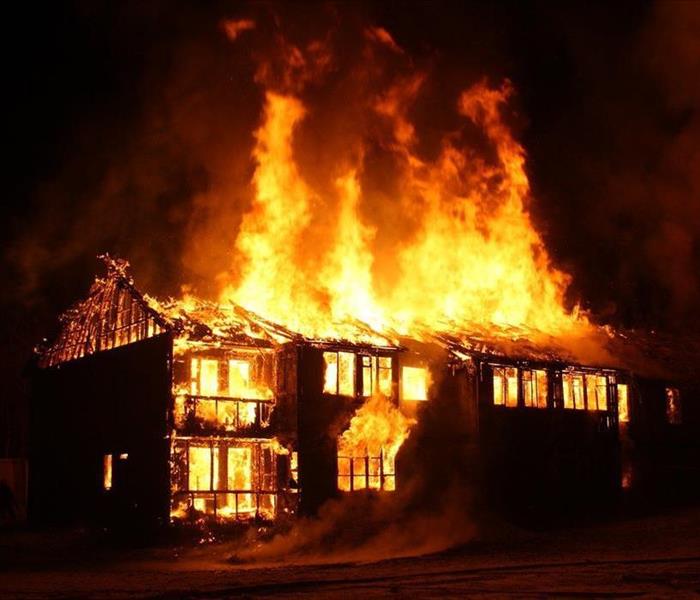
We here at SERVPRO Harrisburg West take the holidays very seriously, especially when it gives us an excuse to decorate the office and dress up. That's why, if you ever stop by the warehouse, you can find members of the team here sporting witch hats and pitchforks as early as October 1st. We really like to go all out and honestly, now that there are bits of bowls of candy everywhere, we can't complain. A lot of us, much like yourselves, are setting up and decking out our houses with all sorts of spooky gear. fog machines, light shows, animatronics, speakers, sometimes even a lifesize talking vampire. Some of our homes have ended up looking like they might as well be the stage for a heavy metal show, and what do both heavy metal shows and decked out houses both need to succeed? A ton of electricity. In fact, a good haunted house has been estimated to cost some owners around $281.32 a week in just electricity. Left unnoticed, these can not only rack up quite a frightening bill but can be a huge fire hazard, turning your Halloween night into an actual nightmare.
So what can you do in order to take the right precautions and keep your home and family safe?
Ditch the CropsA common theme that many people have when setting up their haunted houses makes it look like a farmhouse. It is not unusual to see dried cornstalks, hay bales or piles of wood sitting in front of the houses of citizens. Generally speaking, it is not the safest idea to leave these things around open flames or devices susceptible of causing fires.
Switch to SwitchesWith the previous statement. Who loves a good jack-o-lantern. We sure do. One thing to keep in mind is that most people use open flames in jack-o-lanterns or luminaries, and if you're not careful, this can be another major fire hazard. We suggest converting these to LED lamps. They're reusable, safer, and come in a number of different colors.
Keep an Eye on Your CostumeWardrobe malfunctions are another common concern. Long draping sashes, flowing skirts, acrylic hairpieces, string parts, all these objects can be caught over an open flame, or entangled in some kind of machinery, presenting terrible issues.
Always Check Your EquipmentMaybe it's you who decide to take out some form of heavy power tools or farm equipment and drop them in the front lawn. Always check the equipment before starting it. Gas caps, saw blades, fuel lines, extension cords, ensure proper protection when deciding to mess with heavy machinery on Halloween night. When in doubt, always remember the important acronym, K.I.S.S.
Test Your OutletsParticularly those placed outside in the elements. We at SERVPRO know a lot about "daisy-chaining" and how to do it safely, it's part of the work, but it can get messy quickly. Always make sure how much power you put in and how much the outlet can take before plugging in something else, particularly if your house looks like a death metal album cover.
Accident prevention is the secret to making smart, measured choices that can save you long-term. We still aim to provide people with solutions to daily issues, hoping they will never again need our services. We know how hard house fires can be for families, and we will always be here to get people back in action in their time of need. If all else fails, you can always call your nearest SERVPRO for support.
A Fire Hazard in the Home: The Clothes Dryer
9/21/2020 (Permalink)
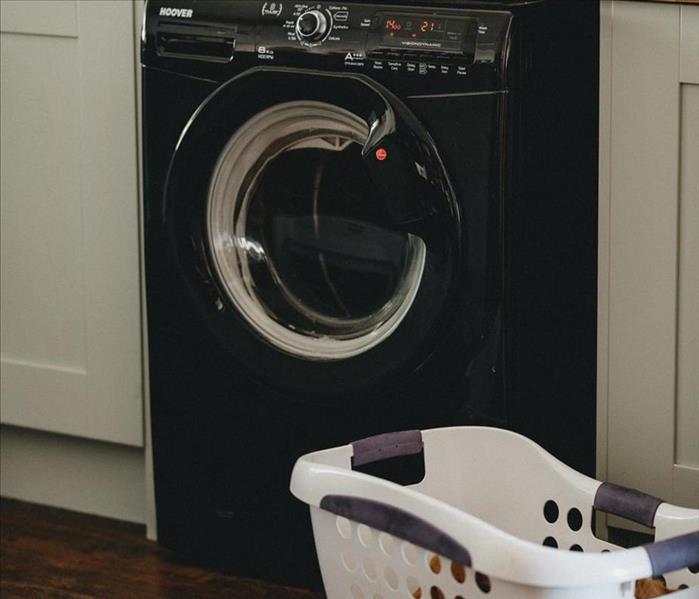 While cleaning the lint filter on a regular basis, it is also important to take several other steps in order to protect your laundry room and the rest
While cleaning the lint filter on a regular basis, it is also important to take several other steps in order to protect your laundry room and the rest
Threatening significant damage, residential fires are a common concern for homeowners. It may be surprising to know that an object in the laundry room is a leading cause of residential fires. According to the National Fire Protection Agency, the clothes dryer, a machine that we use daily, accounts for 92% of laundry room fires. Even if a fire ignites in the laundry room, it is important to note that fires can spread quickly to other areas of the home. For these reasons, it is beneficial to understand why dryer fires ignite so that you can best protect your entire home while continuing to use the clothes dryer regularly.
Clean That Lint Filter!
Neglecting one of the simplest steps when using the dryer, cleaning the lint filter, can result in devastating consequences. One of the primary catalysts for dryer fires is failing to clean them between uses, a task that only takes a few seconds. Lint, which accumulates during each use in the lint trap, is highly flammable in and of itself, but it can also restrict airflow, thus increasing the risk for fire. For these reasons, it isn’t sufficient to only clean the lint filter every few days. Instead, be sure to remove lint from the filter in between every use. By taking a few moments to clean out the lint filter, you can greatly reduce the chances of a dangerous fire igniting in your home.
Other Ways to Prevent Dryer Fires
While cleaning the lint filter on a regular basis, it is also important to take several other steps in order to protect your laundry room and the rest of your home from the potentially devastating consequences of a fire.
- Pay Close Attention To Clothing Labels
If you take a look at the tags of clothes, linens, towels, and other fabric materials, you’ll likely see specified instructions for drying. It is imperative that these directions, which can range from “tumble dry low” to “high heat”, be followed as closely as possible. Items that require low heat sometimes contain types of rubber that should not be exposed to high heat.
- Move Flammable Objects Away from the Dryer
It is not uncommon for household cleaning supplies to be stored in the laundry room. It is important to note that cleaning materials are often flammable. If these items are kept in your laundry room, make sure to keep them a safe distance from the dryer at all times to decrease the chances of any fire that ignites spreading quickly.
- Check the Outdoor Vent Flap
Outdoor vent flaps allow lint and hot air to escape clothes dryers. If the vent flap becomes obstructed by debris of any kind, keeping lint and hot air stuck in the unit, your dryer may be at greater risk for fire. Therefore, it is imperative that outdoor vent flaps are inspected regularly.
If Disaster Strikes…
Even after following all of these steps to prevent a fire from igniting as a result of your clothes dryer, accidents can still happen. If your home has experienced a dryer fire, make sure that SERVPRO is your first call. We understand how distressing residential fires can be and our fire damage experts will work diligently to restore your home quickly, getting things back to normal as soon as possible. Call SERVPRO of Harrisburg West today and learn more about our trusted fire damage services by clicking here.
Condo Fire in Frederick
8/12/2020 (Permalink)
Our parent franchise SERVPRO of Hunt Valley & Harford County was dispatched to a large fire loss in which the roof needed to be addressed so that any incoming storms would not soak through and damage the rest of the condos below. We are always on the lookout for the best technology in order to provide the highest level of service to all of our customers. That's why we're the best in the industry
For more information, and progress photos, check out our Facebook post!
"SERVPRO of Hunt Valley & Harford County, along with SERVPRO of Frederick County were recently called to mitigate a devastating condo fire. The roof of the 12 unit building was completely destroyed. Check out these pictures to see the installation progress on the temporary roof and shrink wrap installed last week. This will protect the condo units through the restoration process until a permanent roof can be rebuilt. Isais didn’t stand a chance."
Fire Up the Barbecue: Gas Grill Safety
6/5/2020 (Permalink)
 It is estimated that an average of 8,900 home fires are the result of gas grills each year, according to the National Fire Protection Association
It is estimated that an average of 8,900 home fires are the result of gas grills each year, according to the National Fire Protection Association
The month of June is famous for backyard barbecues and cookouts. The grill is a staple for
these events and often, they are gas grills, which are usually powered by propane tanks or
cylinders. While grilling should be fun and enjoyable, it is important to recognize that gas grills are a prominent fire hazard. It is estimated that an average of 8,900 home fires are the result of gas grills each year, according to the National Fire Protection Association. By understanding
how to safely go about each step in the grilling process, you can minimize the risk of a fire
igniting while keeping your summer cookouts enjoyable and safe.
Using a Propane Cylinder Safely
It is important to check your propane cylinder for damage, such as rust or dents, prior to use. If
you find that the propane cylinder is damaged, refrain from using that particular cylinder.
Additionally, make sure that the propane cylinder is not overfilled before firing up the grill.
Maintaining a distance of at least 10 ft between the propane cylinder and any combustible items
is crucial at all times. It is also extremely unsafe for children to be within close proximity to the
propane cylinder while it is in use. When not in use, propane cylinders should never be stored
inside. Instead, they should be kept in an outdoor location with sufficient ventilation in an upright
position. However, they should not be kept beside or underneath the gas grill.
Gas Grill Safety
Before any kind of cookout, be sure to check your grill for gas leaks. In order to do this, spray a
soapy water solution on the grill fitting and turn on the gas. Bubbles forming on that line
indicates a leak. Another important step is to check the hose that runs from the propane cylinder to the grill for any holes, which may leak gas. Also, be sure to remove any blockages that you find in the grill, which can range from bugs to old food grease, before you use the grill. Make
certain that the grill is located on a level surface in a ventilated outdoor space and don’t leave
the grill unattended while grilling. At any point while grilling you begin to smell gas, evacuate the
area and call the fire department from a safe distance. In the event of an emergency, it may be
beneficial to have a fire extinguisher on hand.
Once you’re finished grilling and the food is smelling wonderful, don’t forget to completely close the valve of the propane cylinder and turn off the grill’s burner controls. Before placing a cover over the grill, make sure that it has thoroughly cooled down.
In the Event of a Fire…
Adhering to safe grilling practices can reduce the chances of the ignition of an unwanted fire,
but regardless of how careful you are, accidents cannot be completely voided. If your home has experienced fire damage due to a gas grill mishap, be sure to call SERVPRO. From fire damage to smoke and soot damage, our team of skilled fire damage specialists will speedily remediate the damage so that you can continue to enjoy your sizzling summer barbecues and cookouts
this June.
Home Cooking Fire Safety
2/19/2020 (Permalink)
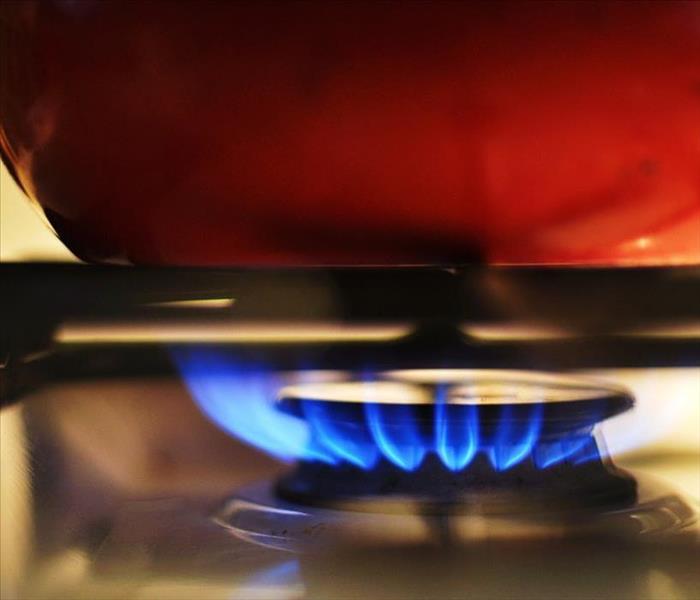 Most, but not all, house fires originate from the kitchen.
Most, but not all, house fires originate from the kitchen.
Did you know that the most common cause of household fires stems from something that many of us do multiple times every day? Cooking can be the culprit of unwanted fires in the kitchen that can spread to other areas if they are not dealt with immediately. You may be wondering, without avoiding cooking, how can the chances of an unwanted fire igniting be decreased? Follow the steps below before and during cooking in order to prevent the ignition of an unwanted kitchen fire while cooking.
Before Cooking
Before turning on the stove or the oven, make sure that your cooking space does not contain any flammable objects, such as paper towels, oven mitts, or towels. Next, be sure to clean any leftover oil, grease, or food debris that may have accumulated on stove tops or inside of ovens since the last time you cooked, as such substances can catch fire easily. In addition to ovens and stove tops, pots and pans can also include grease and oil residue from past cooking experiences. Therefore, it is important to make sure that the insides and outsides of pots and pans are cleaned thoroughly in order to prevent an undesired fire from igniting. Even though it only requires a quick moment of your time, cleaning all cooking surfaces and materials that you plan to use while cooking is a crucial step in protecting your home from a dangerous fire as a result of cooking.
While Cooking
When it is time to begin cooking, it is of the utmost importance that you pay attention throughout the cooking process. The chance of a fire igniting and becoming out of control increases when cooking objects are left unattended. However, it may not always be possible to keep a constant watchful eye while cooking. Therefore, if it is required that you leave the room for a moment while cooking, be sure to temporarily turn off the stove. It may also not be reasonable to be present in the kitchen for the entire period of time required when cooking something that must be baked or roasted for a significant length of time. In this case, remember to check on the cooking at a regular interval in order to decrease the chances of a fire igniting without your knowledge.
Taking preventative measures will help decrease the probability of an unwanted fire igniting while cooking, but even with our best intentions, it is still possible. If your home is equipped with functional smoke alarms and there is a fire extinguisher always kept in the kitchen, your home will be further protected. In the event that a fire breaks out, only attempt to extinguish it yourself if it is small and contained. If the fire is large and unmanageable, exit the house as quickly and safely as possible while making sure that all of the other occupants of the house also escape safely and call 911 as soon as possible. Once the fire has been contained and extinguished, remember to call SERVPRO in order to ensure a speedy and effective repair of any damage caused by the fire.
Space Heater Safety
11/20/2019 (Permalink)
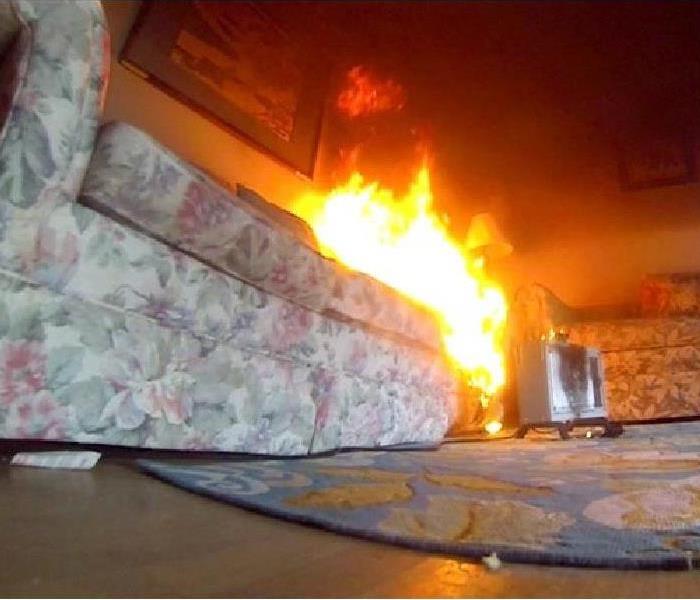 Fire Caused by Space Heater
Fire Caused by Space Heater
As we bid October farewell and enter November, a heated home will be more necessary than ever to provide refuge from the rapidly dropping outdoor temperatures in Harrisburg West. In addition to central heating systems, many homeowners also turn to space heaters for extra warmth. Though space heaters can create a warm and cozy indoor environment, they can also lead to irreparable destruction. According to a 2013 study published by The Consumer Product Safety Commission, an estimated 25,000 residential fires and 300 deaths are caused annually by space heaters. Despite their potential safety hazards, you and your family can safely utilize space heaters and enjoy their warmth during the approaching cold months if you develop a basic understanding of space heater safety.
If space heaters come into contact with combustible objects, such as curtains, furniture, rugs, or clothes, a fire can ignite. In order to avoid such a disaster, at least 3 feet should separate space heaters from any kind of combustible object. It is important to keep in mind that a fire could also ignite if a space heater is knocked over. Therefore, space heaters should be kept on flat, level surfaces and away from popular pathways within the house. Before usage, always be sure to inspect the space heater for any damage to the unit itself, its cords, or plugs. In the event that you discover damage, refrain from plugging it in. Lastly, it is imperative that your space heater is never left unattended while in use. Without someone nearby who could detect the smoke, smoke smell, or observe the first flames, a fire emanating from the space heater could become dangerous and cause destruction. If you must leave the room, always be sure to properly turn off and unplug the space heater.
Exercising caution while using a space heater can help to reduce the chance of a dangerous situation arising, but it cannot eliminate the risk entirely. Therefore, having smoke detectors and alarms installed on each floor of your home would be a beneficial system to have in place in case an accident occurs. It may also be helpful to keep a close eye on children and pets in your home, as injury could result from them coming into contact with a space heater. Finally, if your space heater usage results in a fire, call SERVPRO to restore any fire damage.
Promoting Fire Safety in the Workplace
9/17/2019 (Permalink)
When it comes to home fire safety, many of know the basics: regularly testing smoke alarms, replacing batteries, and knowing the location of our fire extinguishers. Workplace fire safety, however, is a bit more of a grey area. However, informing employees of potential fire hazards, what to do if a fire ignites, and how to exit the office building can prove imperative in protecting your workplace from the potential consequences of a harmful fire.
Taking preventative measures prior to a fire can decrease the probability of your workplace undergoing significant fire damage. Be on the lookout for damaged electrical appliances such as telephones, computers, and even desk lamps, as electrical complications can cause a fire to ignite. Upon discovering a faulty electrical appliance, remove it from the office space and replace it with a piece of equipment that functions properly. In addition, fires can also be prevented by informing office workers of how to properly utilize electrical equipment. Smoke alarms should also be installed throughout the workplace so that workers can be promptly alerted of a fire, allowing them enough time to escape the office. Just as you would in your home, check that the alarms are always working properly and regularly replace their batteries. These alarms should be dispersed throughout the workplace so that the alarm is audible to every employee, regardless of their location in the building.
While it is important to take preventative measures, it is also crucial to have an emergency plan in place that can be implemented in the event of a fire. Employees should know the ins and outs of the plan, including which exit to use and where to meet outside of the building. If employees understand this plan prior to an emergency, exiting the building as efficiently as possible will be a more feasible task. Lastly, all employees should know the location of fire extinguishers in the office and be able to operate them in the event that they are faced with a fire.
Taking preventative measures, always looking for fire safety hazards, and understanding the office’s emergency escape plan can protect your workplace from a potentially devastating fire.
Home Fire Safety 101
8/23/2019 (Permalink)
Igniting in the blink of an eye and spreading throughout your home in a matter of minutes, household fires can leave your home in shambles. Therefore, it is of the utmost importance that your family does everything necessary in order to buy time during a fire emergency. Learning which items to have in your home and how to use them to your advantage can help save time and protect your home from destruction.
Fire Extinguishers
Keeping at least one fire extinguisher in an accessible place in your home can help to douse a fire in its beginning stages. While there are various types of fire extinguishers in existence, there is a specific kind that is best for home use: ABC fire extinguishers. Household fires usually fall under classes A, B, or C. Class A fires signify those that are started by paper, wood, or trash. Class B fires include those instigated by flammable liquids or gases. Lastly, Class C fires indicate those started by electrical complications. Make sure that you feel comfortable using the fire extinguisher so that no time is wasted reading the instructions during a fire.
Smoke Alarms
For each floor of your home, make sure that there is one smoke alarm. For additional protection, install another smoke alarm for every sleeping area. These smoke alarms pick up on smoke as soon as a fire ignites, giving your family as much time as necessary to escape and call for help. In order to guarantee that they are working sufficiently, change the batteries in your smoke alarms and test them routinely. In addition to smoke alarms, putting a carbon monoxide detector in a central location inside of your home can help to also notify your family of the presence of dangerous fumes in your home.
Enforce Safe Practices
Educating your children about basic fire safety can help to keep everyone aware and alert. Inform them of the dangers of playing with fire and keep items such as matches or lighters out of their reach. Finally, talking through what to do in the event of a fire and establishing a meeting place outside as a family can help to keep everyone calm during an emergency.
Preventing Garage Fires
7/29/2019 (Permalink)
Many homes catch fire every year from an unexpected source outside of their home: the garage. The risk of a home catching fire is increased if the garage is connected or attached to the home. As this is a common cause of residential fires, it is important to understand what causes garage fires to start. With the causes in mind, you can take preventative measures to protect your home from the dangers of garage fires.
Archaic or even just aging circuits as well as outlets that are overpowered by too many electrical appliances can spark as a result of these electrical complications. These sparks make the chances of nearby combustible items igniting more likely, which could exacerbate the situation, as those items allow the fire to grow rather quickly. Investigating the state of your garage’s wiring system, which can be completed by an electrician, would be a practical solution to this problem. Alongside of this, stick to wall outlets as your primary power source for electrical appliances in the garage, as relying on extension cords can lead to further electrical issues.
Garages are frequently used as storage solutions, but keeping clutter piled in your garage could escalate the scope of the fire in seconds if one were to ignite. If piles of flammable objects fill your garage, a small fire can gain traction and dramatically increase in size rapidly. Cleaning out your garage can decrease the probability of this happening.
Normally residing in garages, oil, gasoline, paint, and other flammable liquids can become dangerous when met with a flame or spark. These liquids will ignite under such circumstances, fueling the fire and creating a more dangerous situation. Simply storing flammable liquids somewhere like a shed that is a fair distance from your home would be a much safer practice, as the fire would become isolated away from your home.
During the winter months when propane tanks aren’t being used for grilling, some people decide to store the tanks in their garage. Doing so poses danger to your home, however, considering that propane tanks can easily catch fire. Instead of keeping them in the garage, store propane tanks in safer, outdoor areas where there is plenty of ventilation.
In addition to abiding by these guidelines, taking supplemental precautions can help to protect your home in case of an emergency. One of which includes keeping a fire extinguisher either in your home or inside of the garage that could be grabbed quickly in an emergency. Another preventative measure to take includes installing heat alarms in your garage in order to detect a potential fire faster.
How Do Electrical Fires Start?
7/22/2019 (Permalink)
We usually associate items such as candles or matches that generate visible flames with the ignition of household fires, but electrical problems cause a significant percentage of those residential fires. The risk of an electrical fire is enhanced during the winter months, as people turn to heating systems such as space heaters to deal with the cold weather. Understanding which factors cause electrical fires can help you to take preventative measures against them.
What Causes Electrical Fires
Utilizing light bulbs with a greater wattage than what is recommended by a specific light fixture can cause an electrical fire to ignite. Stick to the wattage that is recommended in order to prevent electrical fires from starting. Combustible items, when placed too close to light bulbs, can overheat and ignite, so make sure that items such as cloth and paper are kept at a safe distance away from light fixtures in order to prevent a fire.
If you are using damaged wires that are torn or frayed in order to power electrical appliances, you are at a greater risk of an electrical fire igniting in your home. When wires are damaged, heat can be transferred to nearby combustible items within your home, including rugs and curtains. Be sure to also keep wires off of carpets, as they are combustible and can ignite if a damaged wire is running over top or underneath of them.
Powering electrical appliances using an extension cord when appliances are not located near a wall outlet can enhance the probability of an electrical fire igniting. Electrical appliances must be plugged into wall outlets because extension cords are designed for short-term use and therefore cannot be substitutes for permanent wiring systems. Powering electrical appliances through wall outlets instead of extension cords is a much safer practice and can help protect your home from electrical fires. If doing so seems impossible due to a lack of wall outlets, hire an electrician to install more or stick to the necessities when it comes to powering electrical appliances.
Lastly, keep the age of your home in mind when deciding how many electrical appliances to power in your home. Many homes that are 20 years or older in age were constructed in a time when homes didn’t require as much electrical power, so their wiring systems may not be strong enough to accommodate the volume of electrical appliances found in modern homes. It is also important to recognize that breaker systems in older homes may fail if there is a power overload and therefore give no warning before an electrical fire ignites.
How to Prevent Grease Fires
7/8/2019 (Permalink)
It’s common knowledge that “grease is the word”, but did you know that grease is also a common starter of kitchen fires? From the moment they begin to burn, grease fires can grow rapidly, so it is important to understand how to prevent them. By understanding what constitutes safe methods as well as dangerous methods when cooking with hot oil, you can best protect your home from the destructive effects of grease fires.
Safe Methods
Remove any combustible items from the cooking space before you begin cooking. Cookbooks and paper towels are among the combustible items that, if a grease fire were to ignite, could catch fire and potentially increase the size and severity of the grease fire. While cooking, monitor the cooking space as closely as possible, as grease fires most commonly break out when the cooking space is left unattended. If you intend on drinking any cocktails before the meal, be sure to save them until you have finished cooking. Cooking while under the influence can lead to misjudgment, which could result in dangerous cooking and the ignition of a grease fire. Even if you practice safe cooking habits, the risk of a grease fire starting is always present, so keep a metal lid and baking soda handy when cooking, as they could be used to smother the fire. Keep in mind, though, that you should only rely on baking soda when dealing with a small grease fire.
Dangerous Methods
Refrain from throwing or tossing food into hot oil, as doing so can cause the oil to splatter across the cooking surface and ignite a grease fire. Make sure to gently and carefully place the food into the hot oil instead to prevent the oil from splashing. It is also important if you’re cooking frozen food in oil to allow that food to thaw before cooking. In the event that a grease fire ignites while you’re cooking, abstain from throwing any type of liquid onto the flame. While it is a common reaction to throw water onto any other fire, throwing water or any other liquid onto a grease fire can instead cause the fire to grow.
Preventing Fire Damage in Your Home
7/1/2019 (Permalink)
Preventing Fire Damage in Your Home
How Can Fires Start in Homes?
Several objects that are commonly found inside homes can cause fires including hair spray as well as other aerosol cans, shaving cream, hand sanitizer, and rubbing alcohol among others. It is necessary to be aware that these items are flammable in order to practice caution when handling them.
Electrical Dangers
Blown sockets as well as hot plugs and sockets can increase the risk of a fire igniting in the home. Flames can result from exploded wires that spark, however, a flame does not need to be present for there to be a chance of a fire starting.
Proceed With Caution When…
- Smoking Indoors
Careless smoking while indoors is the number one reason as to why fires start in homes, so extreme caution must be taken when smoking indoors. It is important to completely put out all cigarettes. Also, refrain from falling asleep with a cigarette still burning and using improper ashtrays.
- Burning Candles Indoors
While many of us burn candles inside regularly, it is still important to monitor them in order to protect against candle flames catching any other objects on fire. Candle flames can be blown by drafts such as those originating from open windows. If those drafts reach flammable objects, it can result in a larger and more dangerous fire. Also keep candles in proper candle holders in order to better constrict the flame.
Avoid These Combinations
Avoid placing certain household objects beside one another in order to decrease the risk of fire. Electrical appliances and water should not be placed within close proximity to one another, nor should grease be kept by an open flame or linens/clothes by a heater. Make sure to prevent flames from spreading to other objects from fireplaces by ensuring that it’s protected by a screen or glass doors.
5 Tips For Preventing Fires In Your Home
- Change out frayed wires for new ones
- Check the batteries in your smoke detectors every month
- Check heating devices in your home regularly
- Monitor objects placed on top of hot surfaces
- Store a fire extinguisher somewhere handy
 Developing an understanding of potential fire hazards in the kitchen and becoming aware of fire safety best practices are both ways to be prepared.
Developing an understanding of potential fire hazards in the kitchen and becoming aware of fire safety best practices are both ways to be prepared.





 24/7 Emergency Service
24/7 Emergency Service













